Australian Pain Society NEWSLETTER



VOLUME 41, ISSUE 4, JUNE 2021
BLOG WEB
2 AUSTRALIAN PAIN SOCIETY NEWSLETTER VOLUME 41, ISSUE 4, JUNE 2021 CONTENTS Contents Editor’s note 3 President’s AGM Report - Anne Burke 4 President’s Report - Trudy Maunsell 8 Farewelling Directors 9 Spotlight on new Directors 10 ASM 2021 13 APS Webinars 16 ASM 2022 17 PinC SIG - Acute Paediatric Pain Management and WHO Guidelines 19 PinC SIG - Interview with Ross Drake 21 GYAP 2021 23 Recent Publications 24 Comcare Awards 33 Scholarship 35 Where are they now? 36 Plant a Tree 39 PainStar 41 Events & Notifications 43 FYI 46 New Members 48 Calendar of Events 49 Vision, Mission & Priorities 50 APS Directors 51 Office Bearers 52
Editor’s Note
As the days grow shorter and weather starts to get colder, the eNewsletter is back with a bumper edition!
We open with two President’s Reports – one from our new Immediate Past President Anne Burke and one from our new President Trudy Manusell. I would like to take the opportunity to publicly thank and congratulate Anne for all her outstanding work during her term as President over the last few years. I’d also like to welcome Trudy into the role and look forward to working with you over the coming years. Make sure you cast your eye over both reports to catch up on everything that has been happening with the Society. There is also a comprehensive review of outgoing and incoming Directors to the APS Board. Make sure you check out the updated list of Directors and Office Bearers, as your jurisdictional Director may have changed recently.
Andrew Watson provides a great review of the 2021 Annual Scientific Meeting (ASM). Like Andrew, I was incredibly impressed with how engaging the content was and how smooth all sessions ran. Congratulations to everyone who was involved in putting together such a fantastic event. I look forward to hearing more from the Scientific Program Committee about what they have in store for the 2022 ASM in Hobart, where we will hopefully be back in a face-toface environment. If you missed the talks in ‘real time’ there is no need to fret – all conference recordings will be available via the virtual portal until April 2022. I’ve already taken advantage of being able to catch up on some of the concurrent topical sessions!
Lincoln Tracy
It is great to see APS members engage with the IASP Global Year initiative. 2021 is the Global Year Against Back Pain. Our new President Trudy Maunsell provides a reflective and insightful piece on the advances in managing low back pain over the last four decades. Manasi Mittinty shares a fact sheet highlighting disparities in back pain that she has co-authored with two international colleagues. Both pieces highlight the great range of resources available to help increase our understanding of the nature of back pain and how different treatment approaches can be used.
This edition also features updates from the Pain in Childhood Special Interest Group and recent publications from APS members John Quintner, Melanie Galbraith, and Geoffrey Speldewinde. These features are a great way for members to keep up with the latest events and literature, so submissions such as these are always welcome. Until next time,
Lincoln Editor

3 VOLUME 41, ISSUE 4, JUNE 2021 AUSTRALIAN PAIN SOCIETY NEWSLETTER
EDITOR’S NOTE
President’s AGM Report
To say that the past two years have been unpredictable is probably a bit of an understatement but if nothing else, it has reinforced the importance of rolling with the punches and looking for opportunities amongst the challenges. As you might recall, the APS 2019-2021 Strategic Plan was structured around 6 key priority areas: EDUCATION, ADVOCACY, RESEARCH, SERVICES AND RESOURCES, MEMBERSHIP, and GOVERNANCE. At the time we set the plan we knew that it was ambitious, but what we didn’t know was that within 6 months we’d be facing a global pandemic and 2 years without a face-toface conference. As it turns out, many of the goals that were set within that Strategic Plan became even more important following the onset of the COVID-19 pandemic. I am incredibly proud to say that despite everything that the past 18 months has thrown at us, we have either completed, or are progressing well and are on track to complete, almost every goal that was set.
EDUCATION
The board made a clear commitment in our 2019-2021 Strategic Plan to expand our range of educational offerings and this year we have delivered a suite of new innovations in the education space. In fact, there’s been so much innovation that we’ve reworked our education subcommittee to be the ‘Education and Innovation Committee’; a now critical group in our operational function which has oversight of, and representation from, each of our educational projects. The new educational offerings that we’ve brought to members this year include:
• A highly successful virtual ASM, with webinar package to follow. This was only possible thanks to the vision and creativity of our incredible Scientific Program Committee (led by the ever enthusiastic A/Professor Kevin Keay) and the wonderful team at DCC&A (especially Di Crebbin and Alex Robertson).
Anne Burke
• Four webinars that paid tribute to the 2020 ASM that nearly was.
• BPR Pain Hour – a free regular webinar series that promotes basic pain research (BPR), connects researchers across the spectrum of experience, and supports early career researchers to share and promote their work. This is an incredible offering brought to you by the BPR Special Interest Group.

• A new Pain Management in Aged Care preconference workshop that was delivered for the first time at 2021 ASM and a new Pain Management in Aged Care online training module that is in the final stages of completion and will be launched later this year. This work has been ably led by Tim Austin, with valued input from Trudy Maunsell, Karalyn Huxhagen, Nicole Moore, Fiona Hodson, Steve Savvas, and Marie Vaughan.
• A re-worked version of the Fundamentals of Pain pre-conference workshop which was also delivered successfully at the 2021 ASM and is again, being considered for conversion to an online training module. Sincere thanks to Dr Dan Harvie for leading this work.
Alongside these new initiatives, we have continued to re-imagine the second edition of our Pain in Residential Aged Care Facilities publication for release as an e-book. We had initially hoped to launch it in the first part of this year but that’s been pushed back slightly and will now be released in the coming months, along with the updated version of the PMG Kit which will support this resource.
We’ve also continued to collaborate on two large government funded projects: the national pain education consortium where the APS and the National Aging Research Institute (NARI) have been jointly tasked with developing a train-the-trainer module for pain management
4 AUSTRALIAN PAIN SOCIETY NEWSLETTER VOLUME 41, ISSUE 4, JUNE 2021 PRESIDENT’S REPORT
in Residential Aged Care Facilities and the multidisciplinary pain education strategy project. APS has greatly appreciated the leadership of Professor Michael Nicholas, A/Professor Meredith Craigie, and their respective teams at the Pain Management Research Institute (PMRI) and the Faculty of Pain Medicine (FPM) in driving these exciting projects.
We have also continued to progress planning for the launch of painSTAR – Pain School for Translation And Research – and we are thrilled to welcome IASP, FPM, APRA, and the Australian Rheumatology Association (ARA) as sponsors for this exciting event. Thanks to Professor Rainer Haberberger, Dr Christine Barry, A/Professor Wendy Imlach, Dr Ernie Jennings, and Dr Will Howard for their ongoing commitment to bringing painSTAR to life. After much deliberation and careful monitoring of the national COVID situation, we are thrilled to advise that the inaugural school will be held in November 2021 and applications will open in the near future.
ADVOCACY
Advocacy has remained a strong focus of APS activities this year. We continued to advocate to all state and federal health ministers around the importance of the National Strategic Action Plan for Pain Management and to all members of the Parliamentary Friends of Pain Management group. We also contributed to the Medicare Benefits Scheme (MBS) Implementation Liaison Group and actively lobbied for the importance of funding streams to facilitate adequate access to multidisciplinary care and allied health services in the community. The APS has also continued to advocate to the Royal Commission into Aged Care and associated groups around the importance of quality pain management in aged care, and we responded to consultation around issues such as palliative and end of life care, preventative health, clinical standards, endometriosis, and mental health reform.
The APS has also consulted with numerous organisations around matters related to pharmaceutical reform including opioids, cannabis, and real time prescription monitoring.
Dr Tim Ho took the lead in the opioid space and we thank him for his advocacy to the TGA and representation of the APS at the TGA Opioids Regulatory Communications Committee. We were also proud to support a multi-agency bid, led by Dr Susie Lord, to strengthen the focus on chronic pain across the lifespan and on over the counter analgesic and cannabinoid medication use in the 2022 National Health Survey.
This year it was exciting to see that chronic pain was the focus of the Australian Psychological Society’s National Psychology Week and several members of this APS contributed to the development of a suite of products for this event. The APS has also continued to work closely with Painaustralia, the FPM, and other key stakeholders as we seek to advance pain prevention, management, and research. Several of our cross-sector initiatives have been fostered via the APS Relationships Committee and I thank the committee representatives for their enthusiasm and engagement with APS.
On an international level, APS members have contributed to a range of IASP taskforces. The APS has also connected with colleagues from the Canadian Pain Society around mentoring, association management, and conference production in a pandemic environment, and linked with our New Zealand Pain Society colleagues around aiding pain service reform in that country.
RESEARCH
The APS remains staunchly committed to our PhD scholarship program – the only one of its kind across the IASP chapters - and this year we were thrilled to congratulate Dr Sherelle Casey, our APS/APRA/Seqirus scholar, on the successful completion of her PhD. I extend my thanks once again to the dedicated team at APRA and the PhD Scholarship Committee for their stewardship in this area. We are now in negotiations to secure our next scholarship agreement and we hope to be able to update you on those negotiations soon.
The APS Board has also taken deliberate steps over the past two years to diversify our research support and activities, recognising that PhDs are just one way that pain research is conducted.
5 VOLUME 41, ISSUE 4, JUNE 2021 AUSTRALIAN PAIN SOCIETY NEWSLETTER PRESIDENT’S REPORT
I’ve already mentioned two examples of this diversification - painSTAR which is focussed on fostering the conduct of translational interdisciplinary research and BPR Pain Hour which is focussed on supporting researchers to connect and promote their work. Our APS/ APRA/CFK Clinical Research Grant has also been extended and this year we awarded our fourth grant in what is now a six year agreement that represents a total investment of $180,000 to paediatric pain research from our colleagues at Cops For Kids.
APS also continues to conduct our own research and this year we published our updated Waiting in Pain (WIP) data which indicated that, although there’s been some growth in specialist pain services around the country, we’ve still got work to do in order to ensure that Australians have timely access to evidenced-informed care. The WIP project provides an important voice to a range of issues that pain services experience and we’ve been approached by our colleagues in the New Zealand Pain Society to help support their efforts at reform by conducting a similar project across the ditch. Stay tuned for details on that project.
SERVICES AND RESOURCES
There has been significant innovation in APS services and resources over the past year. As already indicated, we have developed and delivered a range of online learning opportunities including a virtual conference, new or revised preconference workshops, BPR Pain Hour, webinars, and an online learning module. We have also published data from our updated WIP-II project, reimagined our Pain in Residential Aged Care Facilities resource for publication as an e-book (due for release in the coming months) and partnered with Fiona Hodson, Roger Goucke, Dr Steve Savvas, and the team at NARI to update the PMG Kit.
The APS position statement regarding the role of the Psychologist in the management of persistent pain has also been revised under the leadership of Dr Laura Prendergast, and this was presented to the membership for ratification at the 2021 annual general meeting.
MEMBERSHIP
The 2019-2021 Strategic Plan called for us to sustain and grow our membership base. In order to re-invigorate our approach to engaging with members and to strengthen the benefits that come with APS membership by we have:
• Launched numerous online educational opportunities
• Refreshed our communication style and newsletter format
• Included early career positions on our SPC and our Education and Innovation Committee
• Fostered the mentorship of early career individuals to co-chair sessions at the ASM
• Expanded and re-branded our Professional Connection Grant, and
• Started social networking events that were deferred due to COVID-19 and developed plans for mentoring and buddying at conferences, all of which will be released once we can safely return to face to face gatherings.
Ultimately though, the ASM is a key recruitment strategy for APS as we deliberately price registration rates to favour society membership, so I guess it’s not surprising that growth in membership is a goal that we did not achieve. However, although it didn’t grow, it was incredibly well sustained given the impacts that the COVID-19 pandemic has had for many and we believe that we are on track to meet that goal over the coming years.
GOVERNANCE AND OPERATIONS
Governance has been a key focus of our activities over the past two years. Last year we completed the process of becoming a registered charity with Deductible Gift Recipient (DGR) status by presenting the bylaws to support our new Constitution. This year we ceased Corporate Subscribers and revised our ASM prospectus to further strengthen our ethical practices around funding arrangements. The revised prospectus now includes a clause which states that sponsors and exhibitors are expected to:
• Comply with all Australian laws and
6 AUSTRALIAN PAIN SOCIETY NEWSLETTER VOLUME 41, ISSUE 4, JUNE 2021 PRESIDENT’S REPORT
all Therapeutic Goods Authority (TGA) requirements
• Disclose any and all breaches of Australian laws and TGA requirements to the APS before entering into a sponsorship/exhibition agreement and/or as soon as they are aware that they are in breach
• Notify the APS of any activities which may pose a reputational risk to the APS, or compromise the APS’ vision, mission, and priorities.
This new clause established that APS could cancel an agreement that was found to be in contravention of the stated expectations at any time; creating a lever for APS to respond if unforeseen events transpire following the creation of a signed agreement.
We have also drafted a new Governance section for our website to improve transparency of matters such as our approach to ethical practice, declaration of interest policy and sponsorship, exhibition and funding arrangements. The wording for this new section was approved by the APS Board at our meeting on Saturday 17th April 2021 and has been uploaded to the website.
In order to identify other opportunities for improvement, and in line with our membership of the Australian Ethical Health Alliance (AEHA), we also completed a self-assessment of our practices against the principles of the Australian Consensus Framework for Ethical Collaboration in the Healthcare Sector. This assessment was led by Dr Michelle Harris and resulted in the APS being awarded a certificate of completion for the 2020 AEHA Self Evaluation which recognised our continuing commitment to strengthen healthcare delivery through ethical practice.
From an operational perspective, the Secretariat has had a year to remember including state lockdowns, a full year of working from home, health challenges, staffing changes, and redefined workflows. Throughout it all they have shown what a resilient, adaptable, and flexible team they really are. Tracy Hallen is without doubt the backbone of the APS and I cannot thank her enough for her support over this challenging year.
It was fitting that 2020 saw Tracy’s reclassification from Project Officer to Executive Officer – an overdue recognition of the pivotal role that she plays in our organisation and one that I was thrilled to support. My thanks also go to Kristy Gorenc, Sunny Sun, Sandhya Gokani, Di Crebbin, and the broader team at DCC&A for all of the ways in which they’ve pulled together to support APS, to support each other and to support me as we’ve navigated our way through the challenges.
I also need to thank the APS Board and office bearers. They are a truly incredible bunch of dedicated individuals without whom none of the progress that I’ve outlined could have been achieved. I’d also like to thank our members –the engagement that has occurred over this past year is inspirational and I thank you all for getting involved and for supporting the APS.
So, as you can see – despite the unexpected twists – the past two years have been incredibly productive. We developed an ambitious 20192021 strategic plan with clear goals and accountabilities and, despite a global pandemic, we have met almost every single one. We have diversified our interests and activities, refined our organisational processes, strengthened our ethical practices and we have a solid financial basis on which to continue to progress. In short, the APS is well placed to meet the future with optimism and I am excited to see what comes next.
Anne Burke President 2019-2021 Australian Pain Society
7 VOLUME 41, ISSUE 4, JUNE 2021 AUSTRALIAN PAIN SOCIETY NEWSLETTER PRESIDENT’S REPORT
President’s Report
Hi everyone
Welcome to my first President’s report!
I’ve always been told that a short “speech” is a good speech so I’ll try to start my term on the right foot and keep this short and sweet.
For those who weren’t able to join us for the Annual General Meeting on April 21st, please refer to the report from now Immediate Past President, A/Prof Anne Burke, which provides an overview of the Society’s activities and progress during the past two years. What a challenging couple of years it has been! Anne has provided great leadership, enthusiasm, passion, and innovation during her Presidency, and we thank you, Anne, for all your hard work. Anne has always been the first to say that it’s a team effort and that’s very true – we are very lucky to have the team we have had and our new team moving forward.
We bid a sad farewell to retiring team members
Diann Black (previous Director for NT), Shadreck Tozana (previous Director for WA), previous Immediate Past President Fiona Hodson, and Dr Will Howard (previous Secretary). Heartfelt thanks for all you’ve done (and continue to do) and your valuable input – we hope you enjoy a quieter inbox, fewer meetings, a glass of red, and much more family and recreation time!
Trudy Maunsell
Equally we welcome our newly elected directors. We look forward to working with you all and appreciate your commitment to the APS.
Congratulations must also go to the Scientific Program Committee, ably led by A/Prof Kevin Keay and Alex Robertson from DCC&A, for a great online conference. Feedback thus far has been very positive and planning is continuing for a return to a face-to-face meeting in Hobart in 2022, followed by Canberra in 2023. More to come in my next report.
Before signing off, I’d like to reinforce that we are only as strong as our membership. To use one of my (in)famous lines, if your have any “aches, pains, worries, queries or apprehensions” or ideas please don’t hesitate to contact me or your local State Director.
Cheers, Trudy APS President

8 AUSTRALIAN PAIN SOCIETY NEWSLETTER VOLUME 41, ISSUE 4, JUNE 2021 PRESIDENT’S REPORT
Farewelling Directors
Farewell to our retiring President, Secretary, NT and WA Directors
A/Prof Anne Burke
We wish to sincerely thank Anne Burke as she steps down from her role as Australian Pain Society (APS) President.
Anne served as South Australian Director for 6 years from 2011 before becoming President-Elect in 2017 and the President from 2019.

During the last two years, Anne has probably faced the greatest challenge of any preceding APS President: COVID-19 and its many consequences, requiring creativity and flexibility to manage. Ably supported by the APS Board, Anne expertly led the APS through these uncertain times and presided over the first APS Virtual Annual Scientific Meeting, the publication of the updated Waiting in Pain (WIP) data and was instrumental in the development of painSTAR – Pain School for Translation And Research, to name just a few highlights.
We are pleased that we will continue to benefit from Anne’s experience, insights, and professionalism as she continues in an ex-officio capacity as Immediate Past President to the APS Board.
Ms Diann Black
Diann Black has retired from the APS Board as the Director for the Northern Territory having completed her maximum tenure.
Diann first joined the Board in 2015 and was always a passionate advocate for pain management services in the NT, specifically for rural and remote regions in general.
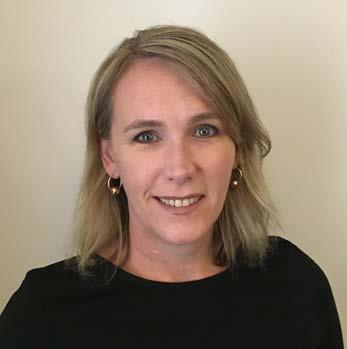
We wish Diann all the best for the future!
Dr Will Howard

We are sad to confirm that Will Howard has retired from the Australian Pain Society Board as Honorary Secretary. Before joining the APS Board in 2015 as Honorary Secretary, Will was Editor of the APS newsletter for 10 years from 2006 to 2015 inclusive and consistently participated as an Office Bearer to the Board during that time.

We will miss his wisdom and sage advice and wish Will the very best in his many plans for his retirement!
Mr Shadreck Tozana
Shadreck Tozana has also retired from the APS Board as the Director for Western Australia, having completed his maximum tenure of 6 years.
Shadreck joined the Board in 2015 and shared his focus of delivering affordable and accessible pain management services for all, especially those in rural and remote communities.
We wish Shadreck continued success in the future!
9 VOLUME 41, ISSUE 4, JUNE 2021 AUSTRALIAN PAIN SOCIETY NEWSLETTER DIRECTORS
Spotlight on our new President, President-Elect, and Secretary
Ms Trudy Maunsell
We are happy to confirm that Trudy Maunsell is the new President for the Australian Pain Society.



Trudy was Queensland Director for six years from 2013, stepped into the role of President-Elect from 2019 and is now President from 2021.
Trudy has a broad range of clinical experience in rural, remote, and metropolitan hospitals as a Registered Nurse and Midwife and has been involved in pain management as a Clinical Nurse Consultant after becoming interested in pain whilst a Nursing Unit Manager of an acute surgical ward in a regional referral hospital.
Trudy’s interests in pain management include clinical care delivery, the establishment of outcome based key performance indicators for acute pain services, and pain management education. Trudy has also conducted several commissioned training programs for nursing staff in Hong Kong and Singapore (when we could still travel!).
Mrs Joyce McSwan
We are happy to confirm that Joyce McSwan is the new President-Elect for the APS.
Joyce joined the APS Board in 2019 as the Director for Queensland.
Joyce is a multiple award-winning clinical pharmacist and educator within the field of pain management. She is the Clinical Director of the Gold Coast Primary Health Network ‘Turning Pain into Gain’ program and Managing Director of PainWISE. Her contributions in the field of persistent pain have been recognised through awards and collaborative industry partnerships with Griffith University, Bond University, Painaustralia, Australian Pain Society, the Pharmaceutical Society of Australia, and the
Pain Management Research Institute. She has been recently appointed the Principal Continuing Professional Development Director of the Australian Health Practitioners Advisory Solutions. She was also recently awarded her Fellowship by the Pharmaceutical Society of Australia. Her expertise lies in innovative health pathway design, piloting and implementing models of care within the primary care setting utilising mixed funding models to optimise pain management, and chronic disease management.
We look forward to Joyce’s continued contributions to the APS Board in her new role.
Mrs Dinah Spratt
We are happy to confirm that Dinah Spratt is the new Honorary Secretary for the APS. Dinah was appointed to the APS Board in November 2018 after the sitting Director for Tasmania resigned. When her position as Director for Tasmania was due for election in 2021, Dinah agreed to step into the role of Honorary Secretary and was appointed by the Board as per our new Constitution.
Dinah moved with her family to Tasmania from the UK in 2006 and has been working in an expanding private physiotherapy practice on the north-west coast since then. She has also worked in an advanced scope role for an orthopaedic spinal surgeon in northern Tasmania for 6 years, assisting in both the diagnosis and management of spinal patients conservatively and pre and post operatively. Dinah has a special interest in the management of spinal and chronic pain conditions, as well as educating both patients and allied health professionals on chronic pain and its biopsychosocial influences. Dinah has completed a MSc in Medicine on Pain Management at the University of Sydney. She gives regular talks entitled ‘Chronic pain from a biopsychosocial perspective’ for patients and is involved in presenting talks to GPs and also to members of her local community on this subject.
10 AUSTRALIAN PAIN SOCIETY NEWSLETTER VOLUME 41, ISSUE 4, JUNE 2021 NEW DIRECTORS
Spotlight on our new NT, QLD, TAS, and WA Directors
Dr Rav (Hari) Harish
We are happy to welcome Dr Rav Harish as the new APS Director for the Northern Territory.

Dr Rav Harish currently works as a specialist in Anaesthesia and Pain medicine in Northern Territory (since 2019). He completed both his Anaesthetic and Pain fellowship training in the United Kingdom in 2006; later immigrated to Australia in 2014 and obtained his dual fellowship in Australia. Previously, he was involved with pain management, education, and training in pain medicine within the multidisciplinary pain unit at the Sunshine Coast University Hospital in Queensland from 2014 to 2019. His interests in pain medicine range from low back pain, neuropathic pain, visceral pain, and complex interaction between pain experience and biopsychosociocultural factors. He also has an interest in addressing the challenges of pain issues in rural and remote Australia through collaborative research and developing initiatives and outreach programs.
Ms Karalyn Huxhagen
Karalyn Huxhagen joined the APS Relationships Committee in March 2019 as the Pharmaceutical Society of Australia representative and we are pleased to now welcome her as the APS Director for Queensland.

Karalyn is a community pharmacist and an accredited consultant pharmacist. She performs locum services, medication reviews, and delivers quality use of medication programs mainly in rural and regional Australia. Karalyn is a consultant to the PainWISE training program as well as many other professional bodies.
Karalyn has a strong interest in pain management, asthma and COPD, aged care, wound care, travel medicine, chronic disease programs, and the health of Aboriginal, Torres Strait and South Sea Islander people. Karalyn is credentialed in Mental Health First aid and she provides immunisation services as a community pharmacist.
Karalyn is a prolific writer, reviewer, presenter, and consultant for many pharmacy organisations, industry and government bodies, and training programs sponsored by manufacturers and health providers.
In January 2010 Karalyn was awarded an Australia Day award for services to the health of the Mackay community and in October 2010 she was awarded the Pharmaceutical Society of Australia Pharmacist of the Year award. Karalyn was awarded a fellowship of the Pharmaceutical Society of Australia in 2010. In 2015 she was awarded the Quality Use of Medicine in Pain Management award by the Pharmaceutical Society of Australia.
11 VOLUME 41, ISSUE 4, JUNE 2021 AUSTRALIAN PAIN SOCIETY NEWSLETTER
NEW DIRECTORS
Ms Bernadette Smith
We are thrilled to welcome Bernadette Smith as the APS Director for Tasmania.

G raduating from UTAS in 1992
Bernadette spent the next 10 years working as a Psychologist for Community Mental Health Services in Tasmania (Child & Adolescent/Adult Community). Bernadette has also worked for UTAS as honorary clinical lecturer with the School of Psychology and Rural Clinical School at the Cradle Coast Campus.
Bernadette moved into private practice (Psychology Plus) in 2003 where she developed a special interest in the treatment of chronic pain and health education. In 2016, Bernadette completed her Master of Science in Medicine (Pain Management) through the University of Sydney. Aside from consulting in private practice Bernadette co-facilitates a federally funded Group Pain Management Program (OPAL) on the North West Coast of Tasmania and has done so for the past 8 years.
Bernadette is also co-director of Pain Solutions, a multi-disciplinary team working with compensable patients suffering chronic pain.
Bernadette is a big supporter of the Pain Revolution; she rode for the first time in 2018 and is currently a mentor for local pain educators through the local pain education program.
Ms Jacintha Bell
We are delighted to welcome Jacintha Bell as the APS Director for Western Australia.

Jacintha graduated as an occupational therapist in 2001. She is a member of Occupational Therapy Australia and the World Federation of Occupational Therapy. In her early career, she worked in inpatient, outpatient, and community mental health services, and then progressed to working in public and private pain clinics. Jacintha established her own occupational therapy practice in 2014, focusing on mental health, persistent pain, and complex/chronic conditions. Jacintha is passionate about enabling people with persistent pain to do the things that are important to them and incorporating participation and meaning into all aspects of service delivery. She is a strong advocate for the inclusion of occupational therapy in multidisciplinary services for people with persistent pain and involved in providing training to health professionals to broaden their skills and abilities in working with people with persistent pain.
We welcome Hari (Rav), Karalyn, Bernadette, and Jacintha, and thank them for their commitment to the APS. We look forward to working with them into the future.
12 AUSTRALIAN PAIN SOCIETY NEWSLETTER VOLUME 41, ISSUE 4, JUNE 2021
NEW DIRECTORS
Post Conference Review: 2021 Australian Pain Society 41st Annual Scientific Meeting
Virtual | 11 April 2021: Pre-Conference Workshops, 19-20 April 2021: Conference
By LOC Chair, Dr Andrew Watson
It is a true pleasure to get the opportunity to present this review of some of the highlights from this fabulous meeting.
Delegates who attended the pre-conference workshops on Sunday 11 April were given a week to absorb everything they learned before the ASM kicked off on Monday 19 April with an inspirational introduction by Peter Rudland, Invictus medalist and pain champion, who in sharing his journey gave us a very powerful and motivating account of the pivotal role all elements of multidisciplinary care played to enable him to manage his pain and achieve highly.
The meeting was informative and energetic, a huge achievement given that it was virtual, and I really thank the Scientific Program Committee (SPC), the SPC Convenor A/Professor Kevin Keay, the Immediate Past-President A/Professor Anne Burke, and the team at DC Conference & Association Management for the amazing program they put together.
The first plenary was fast and furious. Rising Star Award winner from 2020, Dr Sam Robinson, gave a great presentation on his research using animal venoms to explore new nociceptive pain pathways. Professor Lorimer Mosely presented a very engaging update on learning and back pain with great flair and some new insights which are relevant to all clinical domains of pain management. Professor Allan Basbaum then gave a stimulating review of neuropathic pain, with his focus as a researcher not only treating the pain symptoms but rebuilding inhibitory circuits by injecting GABAergic precursors and exploring gene therapy in mice with truly transformational results.
One of the things I loved was the ability to view as many concurrent sessions as you liked: one live and others over following days. All conference recordings are available until April 2022. I invite anyone with a registration to jump back into the Virtual Portal and enjoy any sessions you may have missed. The quality and breadth of speakers was hugely impressive from basic research to clinical practice across the full multidisciplinary spectrum of pain management.
In-between sessions we connected with the Sponsors and Exhibitors on their virtual stands and viewed the digital posters presentations (also still available in the Virtual Portal!)
Congratulations to the Poster Prize Winners – a draw this year! Ms Yanfei Xie from the University of Queensland and Dr Felicity Braithwaite from the University of South Australia. There was also the chance to catch up with people virtually but I can’t wait to catch up face to face in Hobart next year.
The closing plenary on Monday moved from basic research with APS/APRA/Seqirus#1 PhD scholar Dr Sherelle Casey and her work with interactions of THC and CBD in a mouse neuropathic pain model, to Dr Nick Christelis combining interventional pain and allied health, and was closed with Professor Siri Leknes presenting the Sunderland lecture entitled “How opioids shape our feelings; Sorting facts from myths”. The lecture certainly lived up to its name. The effects on mood from trial subjects without pain receiving single dose opioids; (euphoria) or naloxone (dysphoria) were both smaller and more varied than I had thought.
Day two was just as action packed with provoking plenaries from Professor Ian Cameron presenting a wonderful summary of Australian data on pain after motor vehicle crashes and assisting recovery. 2021 Rising Star Award winner Dr Feng Pan presented great work on sleep disturbance and its association with pain.
13 VOLUME 41, ISSUE 4, JUNE 2021 AUSTRALIAN PAIN SOCIETY NEWSLETTER
ASM 2021
Dr Bernadette Fitzgibbon helped us understand the movement towards personalised medicine for non-invasive brain stimulation, and Emeritus Professor Maree Smith then shared a novel target for pain relief in a rat chronic back pain model, the somatostatin 4 receptor.
Choosing between concurrent sessions was again a true dilemma, for when my computer dropped out a couple times the IT support was fabulous and the ease with which I could catch up on exciting concurrent sessions by viewing later more than made up for this.
The closing plenary presentations from Dr Susie Lord looking at equity in pain care distribution, APS/APRA/CFK#3 awardee Dr Nicole Andrews on designing an engaging pain management app suitable for all ages, and Professor Amada C de C Williams on where the evidence on pain management leads us wrapped up an
Gamification Winners
Highest Score
Full APS 2021 Registration Refund
Marinda Rothmans, Flinders Pain Management Unit, SA
Prize Draw Winners
One Day Registration for APS 2022
Mark Bradford, Royal Children’s Hospital
Melbourne, VIC
½ Day APS 2022 Pre-Conference Workshop
Hannah Tregea, Noosa Hospital, QLD
Sharon Keripin, Royal Adelaide Hospital, SA
APS 2022 Gala Dinner Ticket
Alexandra Hobbs, CPL Mylestones, QLD
Lin Tong, Everyday Independence, VIC
Vickie Croker, Hunter New England Health, NSW
extraordinary program leaving me inspired with much to digest and hot tips to incorporate into daily practice.
Gamification within the portal made interacting fun and I want to congratulate all the winners!
Overall, I was astonished at how engaging a virtual conference could be and how smoothly it ran. There was plenty of time for Q&A and panel discussion in all sessions, I know I will be spending some time re-watching some of the plenary sessions just for the discussion time alone!
I know the SPC are already working hard on the APS 2022 program, and I am already looking forward to – hopefully and finally – getting back to meeting with you all in a face-to-face format.
Don’t forget the next webinars in our 2021 Series. Visit the conference website for further information. See you all online!

14 AUSTRALIAN PAIN SOCIETY NEWSLETTER VOLUME 41, ISSUE 4, JUNE 2021 ASM 2021
THANK YOU!
To all delegates who virtually attended APS 2021. We hope that you enjoyed the experience and found it rewarding, beneficial, and educational.
Conference recordings, along with the pre – conference workshops and poster presentations, are now available to access through the APS 2021 Virtual Portal
Delegates can use their log in details to access the Virtual Portal. Please contact the APS Conference Secretariat if you need these details resent.
Members wishing to gain access to the recordings are encouraged to purchase a post-conference registration. Contact the APS Conference Secretariat to organise this.
Recordings will be available until April 2022.
15 VOLUME 41, ISSUE 4, JUNE 2021 AUSTRALIAN PAIN SOCIETY NEWSLETTER ASM 2021
APS 2021 WEBINAR SERIES
A 4-part webinar series was released to augment the 2021 ASM, and we have TWO more to go.
Upcoming Webinars
Tuesday 27 July 2021, 10.00am - 11.00am AEST
Speaker: Professor Allan Basbaum, University California San Francisco, USA

Imaging cortical activity during general anesthesia: preclinical insights into cortical pain processing
Tuesday 31 August 2021, 6.00pm - 7.00pm AEST
Speaker: Professor Siri Leknes, University of Oslo, Norway Pain and anhedonia

Full conference delegates will receive a link to join the webinar shortly before each one.
Registration Fees
Member
$20/webinar
Non-Member $45/webinar
Click here for Webinar Outlines & Speakers
Alternatively, click here to register for the webinar.
For further information, please contact APS Conference Secretariat: aps2022@dcconferences.com.au
16 AUSTRALIAN PAIN SOCIETY NEWSLETTER VOLUME 41, ISSUE 4, JUNE 2021 APS WEBINARS
SAVE THE DATE!
INTERNATIONAL KEYNOTE SPEAKERS
Patrick Mantyh is a Professor of Pharmacology in the Arizona Cancer Centre at the University of Arizona, USA. His interest is to understand the mechanisms that drive skeletal pain and develop new therapies that reduce pain and increase skeletal health.


Imperial College London, UK
Andrew S.C. Rice is a clinical academic active in clinical practice and translational research elucidating neuropathic pain. He is Professor of Pain Research at Imperial College London and Honorary Consultant in Pain Medicine at Chelsea and Westminster Hospital, London.
University of Alabama, USA
Beverly E. Thorn, PhD, ABPP, is Professor Emerita of Psychology at the University of Alabama, where she was on the faculty for 30 years, including serving as Director of the Clinical Psychology PhD program for 15 years and Department Chair for 5 years.

Further information on APS 2022 will be sent out in the coming months, but we have some exciting speakers already confirmed.
We can’t wait to finally get together again for our first face to face meeting in 3 years.
IMPORTANT DATES FOR YOUR DIARY
Wednesday 7 July 2021
Topical Session Submissions Open
Wednesday 28 July 2021
Rising Star Award Applications Open SPC Scholar Position Applications Open Free Paper/Poster Abstract Submissions Open
If you have any questions, please contact the APS Conference Secretariat: aps2022@dcconferences.com.au

17 VOLUME 41, ISSUE 4, JUNE 2021 AUSTRALIAN PAIN SOCIETY NEWSLETTER ASM 2022
INCLUDING Pre-Conference Workshops Topical Sessions Extensive Industry Exhibition Discipline Sub Group Meetings Sponsored Sessions Welcome Reception Conference Gala Dinner Join us online - #auspainsoc www.dcconferences.com.au/aps2022
Professor Patrick Mantyh University of Arizona, USA
Professor Andrew Rice
Dr Beverly Thorn
APS Scientific Program Committee Invitation to Join
The Scientific Program Committee (SPC) is a sub committee of the Australian Pain Society (APS) who organise the Annual Scientific Meetings (ASM). The SPC report directly to the Board of Directors of the APS and consists of the Chair, plus other representatives from basic science and clinical research as well as representatives from diverse professional disciplines.
The SPC is looking for interested APS members to join their team, who can help guide the direction of the ASMs to ensure multiple areas of pain are represented at Australia’s only multidisciplinary conference offering insights into the complex nature of pain management from a variety of medical, nursing, and allied health perspectives.
The Purpose of the SPC is:
• To be a collaborative team that will provide continuity of program from year to year
• To ensure quality and diversity of the program to meet the interest and expectations of members and sub-disciplines of the society
• Ensure a wide spread of topics of national and international interest
• To provide historical perspective on meetings, including keeping an historical record of previous speakers and major topic areas already covered in past meetings
• To support the Convenor and Chair
Responsibilities of the SPC are:
• To determine the theme, content, and international speakers
• To review delegate feedback from prior ASMs
• To invite international speakers
• To invite national speakers
• To nominate speakers for the named lectures
• To determine the topics and speakers for the invited topical sessions
• To ensure the program addresses relevant and current topical issues
• To ensure the committee approves any pre or post conference meetings associated with the ASM and makes a recommendation to the Board for adoption.
• To ensure the planning of the meeting meets the deadlines of the critical path
• To ensure that the planning of the conference is in line with the approved budget
• To review submitted topical sessions and submitted abstracts
• To assist with marketing the ASM and encourage attendance
Responsibilities of SPC members
• SPC video conferences are held every 4-6 weeks on a Tuesday afternoon at 4.30pm (Time zone based on NSW). The meetings last 90 minutes.
• There are 2 longer meetings each year:
– Full day meeting in November
– Half day meeting on the Sunday of each ASM
• SPC members must attend more than 50% of scheduled video conferences
To apply
• Please email APS Conference Manager Alex Robertson with the following information:
– Your resume/CV
– Responses to the following questions:
1. What is your background / area of interest?
2. What do you find attractive about joining the SPC?
3. What would you bring to the SPC?
All applicants must be APS Members.
Applications close Friday 25 June 2021
18 AUSTRALIAN PAIN SOCIETY NEWSLETTER VOLUME 41, ISSUE 4, JUNE 2021 ASM 2022
Updated ANZCA publication for Acute Paediatric Pain Management and WHO guidelines for Chronic Paediatric Pain Management
At the recent video meeting by the members of the Special Interest Group Pain in Children of the Australian Pain Society, we wondered how many colleagues are aware of the updated documents for Paediatric pain management from the Australian and New Zealand College of Anaesthetists (ANZCA), the Faculty of Pain Medicine (FPM), and the World Health Organization (WHO).
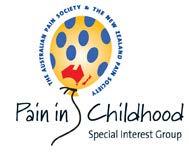
ANZCA Paediatric pain scientific evidence publication
The ‘ANZCA Acute Pain Management: Scientific Evidence 5th Edition’ was published in December 2020 and has the latest best evidence put together from ANZCA and the FPM. Its focus is on acute pain management. Updated every five years, the latest edition has a whopping 1,326 pages and weighs close to 2.5 kg when printed. Hopefully, most people will act environmentally responsible and use the digital PDF file.
Chapter 10 (page 882 – 1175) is dedicated to Paediatric Pain management. It is divided in the following sub-chapters:
• 10.1 Developmental neurobiology of pain
• 10.2 Consequences of early pain and injury
• 10.3 Paediatric pain assessment
• 10.4 Analgesic agents
• 10.5 Opioid infusions and Patient controlled Analgesia (PCA) in children
• 10.6 Paediatric Regional Analgesia
• 10.7 Management of procedural pain in children
• 10.8 Acute pain in children with cancer
• 10.9 Other acute pain conditions in children
• 10.10 The overweight or obese child or adolescent
• 10.11 Complementary and alternative medicines and therapies in children
The ‘ANZCA Acute Pain Management: Scientific Evidence 5th Edition’ can be freely downloaded here:
WHO Paediatric pain guidelines
The ‘WHO Guidelines on the management of chronic pain in children’ were also issued in December 2020. The focus of this guideline is on chronic pain management.
The WHO guideline has less of a comprehensive and specific ‘How to do’ approach than the ANZCA guidelines. Rather, it has a general ‘recommendations’ feeling to it. For example, the WHO guideline recommends “In children with chronic pain appropriate pharmacological management tailored to specific indications and conditions may be used (conditional recommendation, low certainty evidence)” but is does not state how to do it (e.g., which specific medication may be considered). There are additional online appendices that supplement the guidelines. Although one appendix provides ‘systematic review of effectiveness: results, pharmacological therapy’, it is rather short in details. For more specific pharmacology WHO guidelines you can refer to the 2012 ‘WHO guidelines on the pharmacological treatment of persisting pain in children with medical illnesses’
19 VOLUME 41, ISSUE 4, JUNE 2021 AUSTRALIAN PAIN SOCIETY NEWSLETTER PINC SIG
The ‘WHO Guidelines on the management of chronic pain in children’ can be downloaded here:
https://www.who.int/publications/i/ item/9789240017870
The WHO guidelines ‘Web annexes A to K’ can be found here:
https://apps.who.int/iris/bitstream/hand le/10665/337644/9789240017894-eng.pdf
The ‘WHO guidelines on the pharmacological treatment of persisting pain in children with medical illnesses’ can be downloaded here:
https://www.apsoc.org.au/PDF/SIG-Pain_in_ Childhood/WHO_Guidelines.pdf
Kind regards and stay happy and healthy
Dr Arno Ebner, MD PhD FRACP
Paediatrician in Cairns
I can be contacted via the APS secretariat at aps@apsoc.org.au
20 AUSTRALIAN PAIN SOCIETY NEWSLETTER VOLUME 41, ISSUE 4, JUNE 2021 PINC SIG
Talk with Dr Ross Drake
International pharmacovigilance research collaborative to better understand effectiveness and adverse outcomes of medication and other interventions for paediatric pain management – A talk with Dr Ross Drake, Clinical Lead of Paediatric Palliative Care and Complex Pain Services at Starship Children’s Hospital in Auckland (New Zealand)
I had recently the great pleasure to meet our fabulous colleague Dr Ross Drake via video conference and talk to him about a research initiative focused on conducting observational studies in children with chronic pain and cancer pain conditions based at the University of Technology Sydney.
While we all wish for it, high quality data for commonly used medications and interventions for the management of paediatric chronic and cancer pain conditions is often not available. As a consequence, treatment is often based on limited scientific evidence. This is partly due to the high cost and time commitment required for conducting such studies.
To expand our knowledge and subsequently optimise our evidence-based practice, Ross and his team are participating in the RAPID program within the ‘Improving Palliative, Aged and Chronic Care through Clinical Research and Translation’ (IMPACCT) collaboration at the University of Technology Sydney.
The RAPID program is a collaborative international research program designed to collect data and to study the efficacy and adverse outcomes of interventions in chronic pain and palliative care medicine in adults and children. It is called RAPID as it is aiming to rapidly collect, analyse, and report de-identified data and transfer the results quickly into relevant clinical practice reform.
The RAPID paediatric program looking at interventions used in paediatric palliative care
started in 2019, while the RAPID paediatric pain program is due to open its first study this year. Both programs are open for participation for all clinicians worldwide involved in palliative care, cancer care, and chronic pain management in children and more centres are always welcome. For example, the Gabapentinoids (paediatrics) study currently involves sites from the USA, Uruguay, Singapore, Australia, New Zealand, Denmark, and South Korea. As of March 2021, a total of 144 children have been enrolled over the last 18 months.

Currently the following RAPID Paediatric studies are available:
- Gabapentinoids in PPC (closed with analysis of data to begin June 2021)
- Cyclizine for nausea and vomiting
- Telehealth consults for PPC
- Opioids for breathlessness in PPC
- Ketamine for chronic non-cancer pain and cancer pain (due to open mid 2021)
An overview including an introduction video of the RAPID program can be found here
An overview of the paediatric studies including information how to join can be found here
Participants in the RAPID program are encouraged to suggest and lead new studies. In the adult program, such considerations are improving the knowledge about the benefits and harms of methadone or CBD oil for adult palliative care patients.
21 VOLUME 41, ISSUE 4, JUNE 2021 AUSTRALIAN PAIN SOCIETY NEWSLETTER PINC SIG
The focus of the RAPID paediatric series is on interventions for palliative and cancer care with Ross having extended this concept into chronic pain management. I personally would like to also have better evidence for commonplace drug interventions in functional pain syndromes which I think most of the Paediatricians and GPs see and manage frequently in their daily practice (e.g., with medications like gabapentin, amitriptyline, pizotifen, topiramate, and cyproheptadine). In the future it may also enhance our cognition on the use of CBD oil.
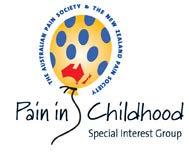
To my mind this type of program also lends itself to examining non-pharmacological measures like the easily accessible self-taught measures like clinician guided relaxation exercises or book and app-based strategies versus the more difficult to access professional allied health support such as clinical psychology or paediatric physiotherapy.
It is time for me to have another talk to Ross.
Dr Arno Ebner, MD PhD FRACP Paediatrician in Cairns
I can be contacted via the APS secretariat at aps@apsoc.org.au
We wish Hayley well and look forward to the outcomes of her study.
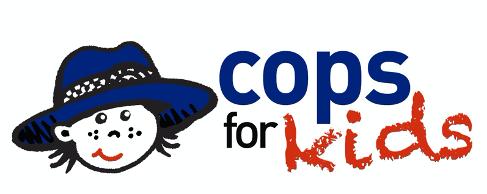
22 AUSTRALIAN PAIN SOCIETY NEWSLETTER VOLUME 41, ISSUE 4, JUNE 2021 PINC SIG
The APS and APRA are proud to continue our sponsorship relationship with Cops for Kids and to announce the APS/APRA/CFK#4 Clinical Research Grant recipient, Dr Hayley Leake.
Dr Leake’s research project is titled: “Co-designing a social media campaign to improve pain science literacy in adolescence”.
Global Year About Back Pain 2021 (GYABP2021)
Trudy Maunsell, President APS Chair, Education and Innovation Committee
The 2021 Global Year Against Back Pain has sent me on a journey down memory lane to the early days of my nursing career and the ways we used to manage acute and chronic back and neck pain. Many a patient was literally anchored to the bed by skin traction for 6 weeks, only rising from the bed for toilet privileges and a quick shower. Not surprisingly, many of these patients found the short jaunt to the bathroom to be more exhausting and painful than a workout in a gym and, I’d suggest, led many a patient down the path of depression, anxiety, fear-avoidance, over reliance on medications, decreased functional ability, and chronicity.
Whilst going through the GYABP2021 fact sheets available from the IASP web page, I found the following top tips for low back pain education and reflect upon how useful this information would have been 40 years ago!
• Encourage people to avoid prolonged rest and to stay active and resume activities as soon as possible, despite having pain.
• Assess and address misconceptions about low back pain (NB: There is a great poster available on the IASP webpage called “Back Facts” by O’Sullivan et al., which you might find helpful for use in your clinic or rooms).
• Explaining why imaging may not be needed.
• Reassuring patients that back pain is not a life-threatening experience but by its very nature, recurrent.
• Informing the patient about the evidencebased options for back pain management.
As we do each year, we have also developed a local Global Year About Back Pain poster

As education and communication with our patients are fundamental components of our management of pain, we need to consider the different modes by which we can provide that information. Chatting with our patients and their loved ones or carers (lets include them in their care and make it patient centred), the provision of written booklets and pamphlets (pitched at an appropriate level and using language the patient understands and catering for CALD patients), audio-visual tools such as videos (which could be shown at GP practices, clinics and emergency departments perhaps), virtual sessions such as via telehealth, online learning or via a blended approach, individual or group sessions, and media campaigns are useful tools to use when getting our message across. No one mode of education delivery is better than the other, but a combined approach may be more acceptable to our patients and be more effective.
Let’s hope that the next 40 years show improved outcomes for our patients!
23 VOLUME 41, ISSUE 4, JUNE 2021 AUSTRALIAN PAIN SOCIETY NEWSLETTER GYAP 2021
Disparities in Back pain
Thank you to APS member Manasi Mittinty for sharing the following recent publication.
Journal Reference: International Association for the Study of Pain
Link: http://s3.amazonaws.com/rdcms-iasp/ files/production/public/Global%20Year%202021_ Disparities%20in%20Back%20Pain.pdf
ABSTRACT
Objective/Background/Aims/Introduction
The International Association for the Study of Pain 2021 year’s theme focuses on helping clinicians, scientists, those living with pain, and the public to understand the nature of back pain and the utility of available treatment modalities. This fact sheet aims to highlight disparities in back pain around the globe.
Conclusions
By developing this factsheet, we hope to help lead to better patient outcomes and contribute towards IASP’s vision of global pain relief.
Declaration
Manasi Murthy Mittinty has nothing to declare.
24 RECENT
AUSTRALIAN PAIN SOCIETY NEWSLETTER VOLUME 41, ISSUE 4, JUNE 2021
PUBLICATIONS
Disparities in Back Pain
1. Health Disparity and Health Equity
Health disparity is defined as “a particular type of health difference that is closely linked with economic, social, or environmental disadvantage” [40] Health equity is consequently “the absence of unfair and avoidable or remediable differences in health among population groups defined socially, economically, demographically or geographically” [38] Disparities in health outcomes have been documented both within and between countries [14; 25] and are stronger determinants of health outcomes than the quality and availability of medical care [5].
2. Disparities in back pain have been documented worldwide.
A recent systematic review of social determinants of health in low back pain across 17 countries showed important associations between gender, race, ethnicity, education, occupation and socioeconomic status and important facets of low back pain (e.g., prevalence, intensity and level of disability) [14] Difference in health because of where you live or your race or gender, have important societal and economic costs.
3. Race and ethnicity are not synonymous.
Race is defined as “physical differences that groups and cultures consider socially significant” while Ethnicity refers to the “shared cultural characteristics such as language, ancestry, practices, and beliefs” [1] Race and ethnicity when used interchangeably fail to capture the distinction that an individual may be of one race but can be multi-ethnic through language, culture, and religion In the presence of inequitable race relations in a society, it becomes very difficult to disentangle ethnicity from race in a meaningful way; in such cases the terms race/ethnicity are used jointly [17].
4. Racial and ethnic disparities lead to under-treatment of back pain.
Racial and ethnic disparities in health care [36] persist even after adjusting for differences in accessrelated factors, needs, preferences, and appropriateness of the intervention Specific to back pain, racial and ethnic disparities in opioid prescribing have been documented extensively in emergency departments and outpatient settings [16; 23; 26; 27] Despite racial/ethnic minorities reporting severe back pain and disability levels, health care providers were more likely to associate less severe pain to them, less likely to refer them for imaging [4] and more likely to recommend non-opioid therapy [23].
5. Racial and ethnic disparities are undermining measurement and understanding of pain experiences in various populations.
Without culturally adapted pain-related constructs, measurement, and interpretation frameworks, racial and ethnic disparities in back pain will persist. For example, application of measures not adapted for use in Indigenous communities in Australia has prevented fully capturing their pain experience [28] and consequently impacted on their pain assessment and treatment. This is important considering that in some communities for example, such as Canadian Mi’kmaq community, there is no word for ‘pain’, only expressions for ‘hurt’ [19]. In this context the use of numeric or faces pain scales as descriptors for pain were perceived as lacking meaning. Efforts have been made to create
©Copyright 2021 International Association for the Study of Pain. All rights reserved. IASP brings together scientists, clinicians, healthcare providers, and policymakers to stimulate and support the study of pain and translate that knowledge into improved pain relief worldwide.


25 VOLUME 41, ISSUE 4, JUNE 2021 AUSTRALIAN PAIN SOCIETY NEWSLETTER
RECENT PUBLICATIONS
culturally adapted scales. For example, a systematic review of cross-cultural adaptation of a functional disability index for back pain, the Oswestry Disability Index, found 27 different adaptation of the questionnaire [43]. Such efforts are a step in the right direction but much more needs to be done in this domain.
6. Women are more likely than men to experience low back pain. Differences in socially constructed masculinity- and femininity-related ways of being and acting (gender) [7] and those characteristics that are biologically determined (sex) have been associated with various facets of back pain experience [42] Prevalence of low back pain is higher in women compared to men (ratio around 1.27), and this difference is greater when women reach the postmenopausal stage [9; 41] Multiple sex-related (e.g., hormonal, differences in the endogenous opioid system) [9; 21] and gender-related (e.g., traits, role expectations, attitudes, stereotypes, norms, status/power asymmetries, ideologies) factors at the intra-individual, situational, positional and ideological levels have been proposed to explain these differences [2], however a complete understanding of back pain in minority groups (including LGBTQI), is poorly documented [21].
7. Sex and gender difference in health care access and treatments for low back pain exist. Women seek health care for low back pain more often and in greater amounts than men [8; 15] This might reflect generally higher levels of health seeking behaviors among women. But this might also be in part explained by their higher levels of reported pain intensity and severity, leading to more frequent health care encounters or prescription of analgesics for example [21]. A theory-guided qualitative review of gender bias in chronic pain suggest that beyond gender norms about pain and pain-related coping, gender bias is present in the treatment of chronic pain that cannot simply be explained by different medical needs [35]
8. Socioeconomic positions are associated with poor back pain prognosis. A recent European study showed that socioeconomic inequalities in the prevalence of back pain might be less pronounced compared to other pain conditions (e.g., hand/arm pain); however, there was great regional heterogeneity [39]. Beyond simply pain prevalence, socioeconomic position, for example education level, has been shown to be associated with recurrence of low back pain and disability, more so than it is associated with new back pain onset [6] The reasons for these inequities are multifactorial and include variability in behavioral and environmental risk factors, occupational status, and barriers to accessing and utilizing health care resources [6] There is also evidence suggesting that childhood socioeconomic position is a risk factor for back pain in adulthood [18; 29] The magnitude of these inequities is on the rise and this seems to be particularly true for men [12] and persist into older adulthood [13].
9. Patient socioeconomic position influences pain assessment and treatment. Unlike race/ethnic or sex/gender characteristics, the role of classism, or categorization of individuals based on their social class, has been less studied in the context of back pain assessment and treatment [11; 34]. Recent studies of classism in chronic pain more broadly suggest that individuals with low socioeconomic position are assessed by health care providers as experiencing lower pain intensity,
©Copyright 2021 International Association for the Study of Pain. All rights reserved. IASP brings together scientists, clinicians, healthcare providers, and policymakers to stimulate and support the study of pain and translate that knowledge into improved pain relief worldwide.

26 RECENT PUBLICATIONS AUSTRALIAN PAIN SOCIETY NEWSLETTER VOLUME 41, ISSUE 4, JUNE 2021
being less credible, and as their pain being more strongly influenced by psychological factors compared to individuals with higher socioeconomic status [3]
10. There is reason to hope for a better future. Different global initiatives have been developed that focus on achieving health equity and minimizing health disparities, for e.g. the US-based Healthy People 2020 initiative [33], the culturally appropriate education program “My Back on Track, My Future” [22] project for Indigenous Australian communities. In addition, Pain Revolution (Australia) [31], Pain BC (Canada) [30], and Flippin’ Pain (UK) [10] campaigns are also examples of recent efforts to adopt a more equitable approach to pain literacy and consumer empowerment. While not specific to back pain, these types of initiatives help gather knowledge and inform policies. Such endeavours can be easily adopted for other minority groups to overcome heath disparities and achieve health equity in back pain.
REFERENCES
1] American Psychological Association. Bias-Free Language. Publication manual of the American Psychological Association. Washington DC: American Psychological ASsociation, 2019.

[2] Bernardes SF, Keogh E, Lima ML. Bridging the gap between pain and gender research: a selective literature review. Eur J Pain 2008;12(4):427-440.
[3] Brandao T, Campos L, de Ruddere L, Goubert L, Bernardes SF. Classism in Pain Care: The Role of Patient Socioeconomic Status on Nurses' Pain Assessment and Management Practices. Pain medicine 2019;20(11):2094-2105.
[4] Carey TS, Garrett JM. The relation of race to outcomes and the use of health care services for acute low back pain. Spine (Phila Pa 1976) 2003;28(4):390-394.
[5] Daniel H, Bornstein SS, Kane GC, Health, Public Policy Committee of the American College of P. Addressing Social Determinants to Improve Patient Care and Promote Health Equity: An American College of Physicians Position Paper. Ann Intern Med 2018;168(8):577-578.
[6] Dionne CE, Von Korff M, Koepsell TD, Deyo RA, Barlow WE, Checkoway H. Formal education and back pain: a review. J Epidemiol Community Health 2001;55(7):455-468.
[7] Dorlin E. L'historicité du sexe. Sexe, genre et sexualités: Presses universitaires de France, 2008. pp. 33-54.
[8] Elsamadicy AA, Reddy GB, Nayar G, Sergesketter A, Zakare-Fagbamila R, Karikari IO, Gottfried ON. Impact of Gender Disparities on Short-Term and Long-Term Patient Reported Outcomes and Satisfaction Measures After Elective Lumbar Spine Surgery: A Single Institutional Study of 384 Patients. World Neurosurg 2017;107:952-958.
[9] Fillingim RB, King CD, Ribeiro-Dasilva MC, Rahim-Williams B, Riley JL, 3rd. Sex, gender, and pain: a review of recent clinical and experimental findings. J Pain 2009;10(5):447-485.
[10] Flippin' Pain. https://www.flippinpain.co.uk/.
[11] Gebauer S, Salas J, Scherrer JF. Neighborhood Socioeconomic Status and Receipt of Opioid Medication for New Back Pain Diagnosis. Journal of the American Board of Family Medicine : JABFM 2017;30(6):775-783.
[12] Grossschadl F, Stolz E, Mayerl H, Rasky E, Freidl W, Stronegger W. Educational inequality as a predictor of rising back pain prevalence in Austria-sex differences. Eur J Public Health 2016;26(2):248-253.
[13] Ikeda T, Sugiyama K, Aida J, Tsuboya T, Watabiki N, Kondo K, Osaka K. Socioeconomic inequalities in low back pain among older people: the JAGES cross-sectional study. Int J Equity Health 2019;18(1):15.
[14] Karran EL, Grant AR, Moseley GL. Low back pain and the social determinants of health: a systematic review and narrative synthesis. Pain 2020;161(11):2476-2493.
[15] Kent PM, Keating JL. The epidemiology of low back pain in primary care. Chiropractic & osteopathy 2005;13:13.
[16] King C, Liu X. Racial and Ethnic Disparities in Opioid Use Among US Adults With Back Pain. Spine (Phila Pa 1976) 2020;45(15):1062-1066.
[17] Krieger N. A glossary for social epidemiology. J Epidemiol Community Health 2001;55(10):693-700.
[18] Lallukka T, Viikari-Juntura E, Raitakari OT, Kahonen M, Lehtimaki T, Viikari J, Solovieva S. Childhood and adult socioeconomic position and social mobility as determinants of low back pain outcomes. Eur J Pain 2014;18(1):128-138.
[19] Latimer M, Finley GA, Rudderham S, Inglis S, Francis J, Young S, Hutt-MacLeod D. Expression of pain among Mi'kmaq children in one Atlantic Canadian community: a qualitative study. CMAJ Open 2014;2(3):E133-138.
[20] LaVeist TA, Gaskin D, Richard P. Estimating the economic burden of racial health inequalities in the United States. Int J Health Serv 2011;41(2):231-238.
©Copyright 2021 International Association for the Study of Pain. All rights reserved. IASP brings together scientists, clinicians, healthcare providers, and policymakers to stimulate and support the study of pain and translate that knowledge into improved pain relief worldwide.
27 RECENT PUBLICATIONS VOLUME 41, ISSUE 4, JUNE 2021 AUSTRALIAN PAIN SOCIETY NEWSLETTER
[21] Leresche L. Defining gender disparities in pain management. Clin Orthop Relat Res 2011;469(7):1871-1877.
[22] Lin IB, Ryder K, Coffin J, Green C, Dalgety E, Scott B, Straker LM, Smith AJ, O'Sullivan PB. Addressing Disparities in Low Back Pain Care by Developing Culturally Appropriate Information for Aboriginal Australians: "My Back on Track, My Future". Pain medicine 2017;18(11):2070-2080.
[23] Ly DP. Racial and Ethnic Disparities in the Evaluation and Management of Pain in the Outpatient Setting, 2006-2015. Pain medicine 2019;20(2):223-232.
[24] Mackenbach JP, Meerding WJ, Kunst AE. Economic costs of health inequalities in the European Union. J Epidemiol Community Health 2011;65(5):412-419.
[25] Marmot M, Friel S, Bell R, Houweling TA, Taylor S, Commission on Social Determinants of H. Closing the gap in a generation: health equity through action on the social determinants of health. Lancet 2008;372(9650):1661-1669.
[26] Meghani SH, Byun E, Gallagher RM. Time to take stock: a meta-analysis and systematic review of analgesic treatment disparities for pain in the United States. Pain medicine 2012;13(2):150-174.
[27] Mills AM, Shofer FS, Boulis AK, Holena DN, Abbuhl SB. Racial disparity in analgesic treatment for ED patients with abdominal or back pain. Am J Emerg Med 2011;29(7):752-756.
[28] Mittinty MM, McNeil DW, Jamieson LM. Limited evidence to measure the impact of chronic pain on health outcomes of Indigenous people. J Psychosom Res 2018;107:53-54.
[29] Muthuri SG, Kuh D, Cooper R. Longitudinal profiles of back pain across adulthood and their relationship with childhood factors: evidence from the 1946 British birth cohort. Pain 2018;159(4):764-774.
[30] Pain BC. https://www.painbc.ca/.
[31] Pain Revolution. https://www.painrevolution.org/.
[32] Politzer E, Shmueli A, Avni S. The economic burden of health disparities related to socioeconomic status in Israel. Isr J Health Policy Res 2019;8(1):46.
[33] Promotion OoDPaH. Healthy People 2020, Vol. 2020, 2020.
[34] Romero DE, Muzy J, Maia L, Marques AP, Souza Junior PRB, Castanheira D. Chronic low back pain treatment in Brazil: inequalities and associated factors. Cien Saude Colet 2019;24(11):4211-4226.
[35] Samulowitz A, Gremyr I, Eriksson E, Hensing G. "Brave Men" and "Emotional Women": A Theory-Guided Literature Review on Gender Bias in Health Care and Gendered Norms towards Patients with Chronic Pain. Pain Res Manag 2018;2018:6358624.
[36] Smedley BD, Stith AY, Nelson AR. Unequal treatment: Confronting racial and ethnic disparities in health care. Washington, DC: Institute of Medicine, 2003.
[37] Social D, Science Integration Directorate PHAoC. Report summary - The Direct Economic Burden of Socioeconomic Health Inequalities in Canada: An Analysis of Health Care Costs by Income Level. Health Promot Chronic Dis Prev Can 2016;36(6):118119.
[38] Solar O, Irwin A. A conceptual framework for action on the social determinants of health. Social Determinants of Health Discussion Paper 2 (Policy and Practice). Geneva: World Health Organization, 2010. p. 79.
[39] Todd A, McNamara CL, Balaj M, Huijts T, Akhter N, Thomson K, Kasim A, Eikemo TA, Bambra C. The European epidemic: Pain prevalence and socioeconomic inequalities in pain across 19 European countries. Eur J Pain 2019;23(8):1425-1436.
[40] U.S. Department of Health and Human Services. The Secretary’s Advisory Committee on National Health Promotion and Disease Prevention Objectives for 2020. Phase I report: Recommendations for the framework and format of Healthy People 2020 [Internet]. Section IV: Advisory Committee findings and recommendations, 2010.
[41] Wang YX, Wang JQ, Kaplar Z. Increased low back pain prevalence in females than in males after menopause age: evidences based on synthetic literature review. Quant Imaging Med Surg 2016;6(2):199-206.
[42] Wu A, March L, Zheng X, Huang J, Wang X, Zhao J, Blyth FM, Smith E, Buchbinder R, Hoy D. Global low back pain prevalence and years lived with disability from 1990 to 2017: estimates from the Global Burden of Disease Study 2017. Ann Transl Med 2020;8(6):299.
[43] Yao M, Wang Q, Li Z, Yang L, Huang PX, Sun YL, Wang J, Wang YJ, Cui XJ. A Systematic Review of Cross-cultural Adaptation of the Oswestry Disability Index. Spine (Phila Pa 1976) 2016;41(24):E1470-E1478.
AUTHORS
M. Gabrielle Pagé*, PhD, Assistant professor and research scholar, Department of Anesthesiology and Pain Medicine, Faculty of Medicine, & Department of Psychology, Faculty of Arts and Science, University of Montreal, Montreal, QC, Canada; gabrielle.page@umontreal.ca
©Copyright 2021 International Association for the Study of Pain. All rights reserved. IASP brings together scientists, clinicians, healthcare providers, and policymakers to stimulate and support the study of pain and translate that knowledge into improved pain relief worldwide.

28 RECENT PUBLICATIONS AUSTRALIAN PAIN SOCIETY NEWSLETTER VOLUME 41, ISSUE 4, JUNE 2021
Manasi Murthy Mittinty, MD (Medicine), PhD, Co-chair of the Sex, Gender and Race Special Interest Group of the International Association for the Study of Pain; Lecturer, Pain Management Research institute, University of Sydney, Australia
Kobina Gyakye deGraft-Johnson, MBChB, FGCS (Anaesthesia), PGDip Interdisc Pain Mgt, Consultant Anaesthetist and Pain Specialist, Korle Bu Teaching Hospital, Accra, Ghana
ACKNOLEDGMENTS
MG Pagé is a Junior 1 research scholar from the Fonds de recherche du Québec en santé.
REVIEWERS
Lorimer Moseley AO
Chair in Physiotherapy
UniSA Allied Health & Human Performance
University of South Australia
Australia
Sónia F. Bernardes
Associate Professor with Habilitation
Department of Social and Organizational Psychology
ISCTE-IUL
Lisbon, Portugal
©Copyright 2021 International Association for the Study of Pain. All rights reserved. IASP brings together scientists, clinicians, healthcare providers, and policymakers to stimulate and support the study of pain and translate that knowledge into improved pain relief worldwide.

29 RECENT PUBLICATIONS VOLUME 41, ISSUE 4, JUNE 2021 AUSTRALIAN PAIN SOCIETY NEWSLETTER
The Great Tradeoff in workers’ compensation: perceptions of injustice by those experiencing persistent pain
Thank you to APS members John Quintner and Melanie Galbraith for sharing the following recent publication.
Article first published online: April 2, 2021
Journal Reference: Pain Medicine
DOI: 10.1093/pm/pnab123
Link: https://academic.oup.com/painmedicine/ advance-article-abstract/doi/10.1093/pm/ pnab123/6209022
ABSTRACT
Introduction
Some claimants harbor perceptions of injustice about the way they have been treated. In particular, those with ongoing and disabling pain have been generally dissatisfied by the way they have been managed by the systems designed to offer them financial compensation.
Aim
To explore possible factors that may contribute to their dissatisfaction.
Method
We review the historical development of the various systems in which monetary compensation was awarded for personal injury.
Findings
In the latter years of the 19th century, a significant trade-off occurred in the German workers’ compensation systems. On the one hand employers accepted the principle of no-fault insurance and agreed to provide injured workers with monetary compensation and medical treatment. On the other hand, employees agreed to relinquish the right to sue their employer for negligence. However, awards under this legal system did not include assessments for ongoing pain, humiliation, or loss of social status as were incorporated in previous systems.
Conclusion
Although the Prussian and German approach provided a utilitarian model for similar systems around the world, its failure to include some long-established benefits of a moral nature may have contributed to the current perceptions of injustice expressed by many injured workers experiencing persistent pain.
30 RECENT PUBLICATIONS AUSTRALIAN PAIN SOCIETY NEWSLETTER VOLUME 41, ISSUE 4, JUNE 2021
Patient expectancy does not predict success or failure of thermal neurotomy for persistent zygapophysial and sacroiliac joint pain
Thank you to APS member Geoffrey Speldewinde and his colleague Cat Panwar for sharing the following recent publication.
Article first published online: 08 April 2021
Journal Reference: Pain Medicine
DOI: https://doi.org/10.1093/pm/pnab133
Link: https://academic.oup.com/painmedicine/ advance-article-abstract/doi/10.1093/pm/ pnab133/6217367
ABSTRACT
Objective
The placebo effect is important in determining the outcome of the treatment of pain for which expectancy and context are the main contributors. The variable success of thermal neurotomy spinal pain procedures is often seen as evidence of the placebo effect. Conversely proponents of pain procedures explain poorer outcomes on technical procedure deficiencies including inadequate diagnosis.
This cohort study set out to determine if patient expectancy is a contributing factor in the outcome of thermal neurotomy to cervical, thoracic, and lumbar zygapophysial and sacroiliac joints.
Design
This single practitioner, single site retrospective analysis of prospectively gathered cohort data of 549 patients evaluated the impact of patient pre-procedure expectancy using a simple 0 to 10 or 0 to 4 Numerical Rating Scale on outcomes in a large consecutive series of patients who
had undergone thermal neurotomy treatment between 2009 to 2019. In addition, a portion of patients were asked to what extent did they hope or desire a good outcome.
Results
Successful pain relief ( ≥ 75% reduction from baseline) was not associated with a higher preprocedure expectancy than failed procedures. Hope and desire demonstrated no impact on the positive or negative impact of the procedure.
Conclusions
Altogether neither patient expectation of outcome, hope nor desire are associated with the outcome of common and effective pain relief by thermal neurotomy which has been performed to the appropriate and commonly available technical standards. Further work is needed to determine the influence of patient expectation across a range of pain intervention modalities.
Commentary
Unfortunately, the role of interventions in the management of pain continue to be misunderstood, misapplied, and misused in common practice. I, like many others with a proficiency in interventions, provide these to my patients in the context of a multi-dimensional assessment and management for any given patient. As I have long reported, it isn’t for more CBT, activity encouragement, pharmacology etc. that patients return unbeckoned months or years later, but repeat or further interventions for more accurate diagnosis and the periods of pain relief that they describe?
This ground-breaking paper provides further and novel evidence that it isn’t placebo, expectancy, hope, or desire that provides the
31 RECENT PUBLICATIONS VOLUME 41, ISSUE 4, JUNE 2021 AUSTRALIAN PAIN SOCIETY NEWSLETTER
benefit that the patient has reported. It is the reduction in the ‘painfulness’ (as I read in NOI recently) when the intervention is performed as best as possible to the scientifically bestestablished standards for offering these. I would thereby hope that it encourages all to be seriously considering, if not necessarily offering, an evidence-guided interventional diagnostic and thence potentially therapeutic option as a lesser or greater part of the assessment and management of a person’s pain.
A valuable additional window of opportunity is created for that person to optimise their chosen way(s) of coping with their pain situation. I put it to you that THIS is the headline of the efforts of the Australian Pain Society- ‘Helping Australians Cope With Their Pain’!
Declaration
Geoffrey Speldewinde has nothing to declare.
Have you had an article accepted for publication this year?
The Australian Pain Society (APS) is keen to share publications from our members with their colleagues via our eNewsletter. If you’ve had an article accepted or published recently, please contact our Assistant Editor Joanne Harmon via the APS Secretariat ( aps@apsoc.org.au ) with the title, authors, and reference (i.e., journal, volume, and DOI) of your article and request the submission template. We would love it if you also supply a short commentary (300 words max) to give our readers the gist of the article.
32 RECENT PUBLICATIONS AUSTRALIAN PAIN SOCIETY NEWSLETTER VOLUME 41, ISSUE 4, JUNE 2021
2021 Comcare National Work Health and Safety Awards
We would like to congratulate APS members Professor Michael Nicholas and Dr Manasi Murthy Mittinty whose EMCAP research project partnership with Australia Post WON Category 3 –Recovery at and Return to Work Award at the 2021 Comcare National Work Health and Safety Awards.
Early Matched Care at Australia Post (EMCAP) Australia Post
About Australia Post
As Australia’s leading logistics and integrated services business, Australia Post connects Australian communities to each other and the world, supporting customers to grow and thrive and creating products that people trust. The in-house rehabilitation team manages occupational rehabilitation services for 34,000 employees nationally.
The problem and/or challenge
Examination of rehabilitation cases with long recovery duration and/or high degrees of complexity revealed an emerging trend of workers sustaining a work-related physical injury and developing secondary psychosocial risk factors. As a result, the business was being impacted by lost productivity and increasing workers’ compensation costs. Australia Post established the Early Matched Care at Australia Post (EMCAP) program to:
• Identify workers at risk of delayed recovery and disability within the first week(s) of injury and provide support
to them prior to escalation into a more serious claim or a prolonged absence from work
• Reduce the burden of secondary psychological risk factors on recovery and early return to work
• Develop an industry leading practice, evidence-based model of intervention
• Contribute to the scheme by developing a scalable and accessible protocol that delivers both economic and health outcomes
• Assist operational managers in the early detection and management of secondary psychological risk factors.

The approach and outcome
In consultation with the University of Sydney, the Australia Post Group (APG) undertook a 12-month controlled trial of early identification and intervention for injured workers at risk of delayed recovery and disability as a result of their work-related injury. A key consideration for this study was the ability to integrate the protocol into the existing injury management system upon completion. This required the protocol to be scalable, cost effective, and available nationally.
33 VOLUME 41, ISSUE 4, JUNE 2021 AUSTRALIAN PAIN SOCIETY NEWSLETTER
COMCARE AWARDS
An extensive period of consultation with key stakeholders including senior and operational management, allied health professionals, and the Union was undertaken during the study development phase and an education campaign rolled out to ensure support and commitment. The EMCAP study recruited APG workers from new compensation claims and each participant was screened for inclusion in the study at their initial assessment with their Workplace Rehabilitation Provider using the Orebro Musculoskeletal pain screening questionnaire. As part of the intervention group, workers were offered up to six sessions with an EAP practitioner, where return to work barriers were identified and discussed. These practitioners had a background or interest in occupational rehabilitation and were offered extensive training and support to participate in the program. The practitioners were not referred to as counsellors or psychologists to encourage buy-in from participants. The WRPs maintained contact with the counsellor and GP to support workers early recovery and return to work.
Key achievements
• High participation rates for those consenting to be screened and in the utilisation of the counselling program with significantly improved return to work outcomes (e.g., pre-injury hours), reducing incapacity costs
• Early identification and management of unhelpful thoughts relating to injury and recovery and reduced incidence of psychological distress
• Greater collaboration with all allied health professionals involved in the care of the individual, during the initial stages of injury, with positive feedback from internal and external stakeholders
• Participants in the intervention group have returned to pre-injury hours on average 51 days more quickly than those in the control group resulting in a positive impact on their families and communities
34 AUSTRALIAN PAIN SOCIETY NEWSLETTER VOLUME 41, ISSUE 4, JUNE 2021 COMCARE AWARDS
APS/APRA/Seqirus #1 PhD Scholar Graduation
This is an outstanding achievement for Dr Casey and the culmination of significant effort and determination on her part, particularly in light of her ongoing neuropathic pain for which she had multiple failed treatments during her candidature.
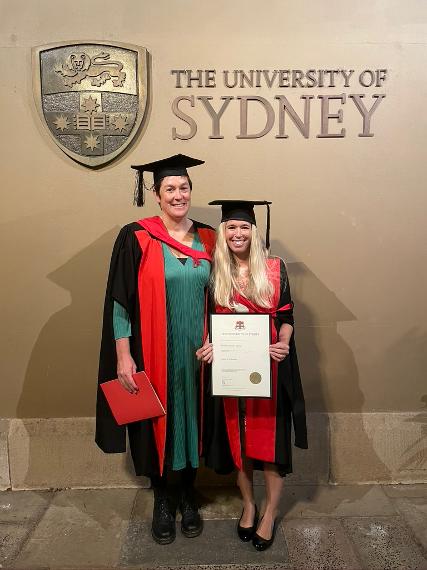
Sherelle’s research topic and thesis title was “Cannabinoids for neuropathic pain”, and she completed her studies at Pain Management Research Institute (PMRI) under the supervision of Prof Christopher Vaughan and A/Prof Karin Aubrey.
The APS has proudly partnered with the Australasian Pain Relief Association (APRA) and industry sponsors to support our flagship PhD program since 1995. Our support extends to giving our PhD candidates the opportunity to present at our Annual Scientific Meetings (ASMs), which proves to be a valuable experience. We are pleased that Sherelle presented her research in a topical session in 2017 in Adelaide, and in plenary sessions in 2018 in Sydney, 2019 at the Gold Coast, and at the virtual 2021 meeting. The 2020 meeting, which was meant to be in Hobart, was cancelled due to the pandemic.
We are grateful for Seqirus’s unrestricted sponsorship of the APS/APRA PhD Scholarship Program, and are delighted to acknowledge the successful completion of Dr Casey’s research, made possible by the APS/APRA/Seqirus #1 PhD scholarship.
35 VOLUME 41, ISSUE 4, JUNE 2021 AUSTRALIAN PAIN SOCIETY NEWSLETTER SCHOLARSHIP
Congratulations to Sherelle Casey, the APS/ APRA/Seqirus #1 scholar who has recently been awarded her Doctor of Philosophy (PhD).
APS/APRA PhD Scholarship Awardees: Where are they
now?
In this new series Assistant editor Dr Joanne Harmon reaches out and chats with previous recipients of the APS/APRA PhD scholarship. For this issue, Jo caught up with A/Prof Susan Slatyer and asked her to go back in time to when it all began, when she was awarded an APS/APRA PhD scholarship for her PhD in Nursing. Below is an edited transcript of their conversation.
“I don’t think you realise at the beginning how much of an impact it will have on your career.”
In 2006 Susan Slatyer was awarded the APS/ APRA PhD scholarship for her Nursing PhD titled “The role of empowerment in the care of patients who experience severe pain: The nurse’s perspective”. She undertook a qualitative grounded theory study, that involved 92 hours of observation in acute care hospital wards, 12 structured observations of nurses in the process of care of caring for hospitalized patients in severe pain, and 33 in-depth interviews with nurses. She collected these data on four acute care wards, renal gen/ med, orthropaedics, eye/ENT plastics, and respiratory. Theoretical sampling, a characteristic of grounded theory methodology, directed her choices to collect data on each of these wards to flesh out the emerging categories in the data that would form the final substantive theory.
Susan recalled a pivotal point in her PhD when a prominent theme emerged from the interview data. Nurses seemed to respond very differently to patients who had acute pain on a background of chronic pain who didn’t seem to present with the expected signs of severe pain and as such, the nurses tended not to prioritise attending to them. This directed her to collect data from the respiratory ward, where several patients with chronic medical conditions were treated.
“The first ward I went to every day for a month, and I started to “go native”- I started to feel like I was one of the staff, so I had to pull back. I was doing the analysis after finishing the observations. I was going right into depth with the data, then extracting myself – looking critically at the literature and aiming to have understanding on what it was that I had seen. From this the notion of empowerment emerged.”
Susan described how she saw nurses aiming to empower themselves to provide comfort for their patients through medication and their emotional presence. They described their personal distress in seeing the suffering of a patient in severe pain, particularly when they felt unable to relieve that suffering despite their best efforts. When these situations persisted, it was evident that nurses would try to withdraw from interactions with these patients to protect themselves. Susan recalled how through analysing the data and considering the categories and themes in light of the literature, she was able to conceptualize the boundaries nurses were implementing while attempting to comfort patients with severe pain, and the personal and environmental factors influencing their responses.
Susan found winning the APS/APRA PhD scholarship to be a pleasant surprise.
“Well, I was such a new researcher, I didn’t expect to be successful I must say! … It came just at the right time. The road at the beginning of my PhD it was quite bumpy, without the scholarship I might well have withdrawn from the PhD. It was the scholarship that kept me in it [the PhD], as initially I felt I had a responsibility or an obligation to the scholarship to finish the PhD. It was the scholarship that actually kept me going, it was really valuable in that way as it kept me motivated and on track.”
36 AUSTRALIAN PAIN SOCIETY NEWSLETTER VOLUME 41, ISSUE 4, JUNE 2021 WHERE ARE THEY NOW
When invited to expand more on the impact of the APS/APRA PhD scholarship, Susan shared her experiences of being a PhD student.
“Because I encountered some stumbling blocks in the PhD journey, not unlike many PhD students do early on, I was starting to have doubts and thinking it was too hard. But because I had the scholarship, I had to keep going … it was the commitment I had made to the APS/APRA scholarship that was what really got me through. You see it was the recognition by APS/APRA by awarding me the scholarship … that was what really kept me going through at the beginning.”
Susan recalled the benefits offered by the scholarship. “Certainly, from a monetary perspective I was able immerse myself in the fieldwork and collect my data, do the interviews, and undertake the actions required by qualitative research in relation to the physical documentation of memos, journals, and diaries. The scholarship provided me with the mental space to be able to do that … really immerse myself into my data collection. This scholarship has provided me with many other aspects apart from the money, on reflection I can now see I can owe [the scholarship] my career in academia and being able to gain a PhD that I would not have had otherwise.”
Ten years after being awarded the APS/ APRA scholarship, Slatyer was named 2016
Western Australian Nurse of the Year. Susan reflected on how her PhD, enabled by the APS/APRA scholarship, was the foundation for a satisfying and impactful career.
“My career progressed because my PhD was within a hospital clinical context, and this opened many doors for me. For instance, I was able to gain conjoint appointments between the Sir Charles Gairdner Hospital and both
Curtin University (2013-2018) and Edith Cowan University (2010-2013). Now I am an Associate Professor of Nursing at Murdoch University. I now hold honorary research consultant positions at Sir Charles Gairdner Osborne Park Healthcare Group and Fiona Stanley Fremantle Hospitals Group. I am now in a teaching and research role. Going back to the scholarship, it really changed the direction of my career, and without it, I would not have a career in academia. It enabled me to build not only research skills but also networks and multi-disciplinary professional relationships … although pain is not the whole component of my work now, I would not have that without the scholarship.”
“To be honest, it was the support of the APS at the time. They provided me with the ability to be able to, for instance, do a yearly presentation for 10 minutes at their conference with other academics. And to be immersed in that Society, to meet my peers, it was a great opportunity and to be able to attend the conferences, have access the resources was really inspiring and gave me direction for my career. I was able to be immersed, meet, and be exposed to others and be able to share knowledge. So, I am very grateful to the APS and I am really looking forward to the next conference in 2022 and having opportunities to present. Everyone was so supportive, and I can still remember the other presentations that were on, and today I still have some of the social networks in place from when I did that first event.”
“I still do work on assessment and management of pain as a nursing perspective. I now focus more on the care of the older person and the needs of family caregivers. I have just edited a book titled Gerontological nursing: A holistic approach to the care of older people, which included co-authoring the chapter on pain assessment and management with Dr Roger Goucke.”
37 VOLUME 41, ISSUE 4, JUNE 2021 AUSTRALIAN PAIN SOCIETY NEWSLETTER WHERE ARE THEY NOW
Susan is also developing educational resources for undergraduate nurses and registered nurses using short audiovisual (AV) simulations of nurses modelling evidence-based pain assessment and management practice in hospital patients with various characteristics. Results from evaluation of the AV simulations with student and employed nurses to explore positive effect on nurses’ levels of compassion and feasibility in nursing education are promising.
Keep your eyes peeled for the publications forth coming, and I am sure Susan will provide a summary of these for sharing in the APS newsletter. Want to catch up on what A/Prof Slatyer is up to now? Check out some of the links below to her work.
Clinical Interventions in Aging
Gerontological nursing: A holistic approach to the care of older people.
Bed Moves, Ward Environment, Staff Perspectives and Falls for Older People with High Falls Risk in an Acute Hospital: A Mixed Methods Study
Collegian
Enhancing students’ preparedness to care for older people: A mixed methods analysis
BMC Health Services Research
Caregivers’ experiences of a home support program after the hospital discharge of an older family member: a qualitative analysis
Dementia
Development and pilot testing of the “focus on the person” form: Supporting care transitions for people with dementia
Mindfulness
Evaluating the Effectiveness of a Brief Mindful Self-Care and Resiliency (MSCR) Intervention for Nurses: a Controlled Trial
38 AUSTRALIAN PAIN SOCIETY NEWSLETTER VOLUME 41, ISSUE 4, JUNE 2021
WHERE ARE THEY NOW
THANK YOU!
The Australian Pain Society and DC Conference & Association Management are committed to producing environmentally friendly events.
As an inaugural initiative, we worked with Carbon Neutral to plant a tree for every registered delegate. Further to this, delegates were invited to purchase their own trees through the registration form. The 7 pre-conference workshop convenors also contributed $1000 worth of trees as speaker gifts.
In total 1351 trees will be planted in the Yarra Yarra Biodiversity Corridor. Collectively we have filled nearly half of the Melbourne Cricket Ground!

This Corridor is in the northern wheat belt region of Southwest Australia, significantly one of only 35 global biodiversity hotspots. These are regions that have an exceptionally high number of plant and animal species found nowhere else in the world. The biodiversity hotspot label recognises that these plants, animals and ecosystems are at extreme risk of destruction.
A special thank you to all delegates who purchased their own trees, 424 trees to be exact!
For further information on where trees will be planted, please click here. This program will be available as part of APS 2022.

39 VOLUME 41, ISSUE 4, JUNE 2021 AUSTRALIAN PAIN SOCIETY NEWSLETTER PLANT A TREE
This is to recognise The Australian Pain Society on behalf of Delegates of the 2021 Australian Pain Society

41st Annual Scientific Meeting
1,351
for contributing 1,351 native trees and shrubs in the Yarra Yarra Biodiversity Corridor.

Thank you for supporting biodiverse reforestation and habitat restoration within Australia’s largest carbon sink project.

40 AUSTRALIAN PAIN SOCIETY NEWSLETTER VOLUME 41, ISSUE 4, JUNE 2021 PLANT A TREE
Proudly restoring Australia’s natural habitat through biodiverse reforestation of degraded land.
Issue Date: 26 May 2021 Carbon Neutral Pty Ltd is regulated by the Australian Securities and Investments Commission and holds Australian Financial Services Licence Number 451004
Ray Wilson | Chief Executive Officer
Established by the Australian Pain Society - the Pain School for Translation And Research
CALLING ALL EARLY CAREER RESEARCHERS
Do you want to link with some of the best pain minds in Australia around issues like research translation and influencing policy, and participate in a range of pain labs and workshops?
If yes, this is the event for you!
Inaugural event in South Australia 14-18 November 2021
Important dates:
Application start date: OPENING SOON
Application deadline: 14 July 2021
Notification date: 11 August 2021
painSTAR aims to:
• Bring together the brightest lights in early career and expert pain researchers
• Create a ‘Pain Think Tank’ to drive innovation
• Have committed and spirited minds in one place to define problems and identify avenues to find solutions
• Have access to latest results and discuss emerging trends
• Enable cross-disciplinary collaborations between researchers, clinicians, consumers, and industry in order to grow translational thinking
For further information and to find out how you can participate in this exciting venture, go to the website
41 VOLUME 41, ISSUE 4, JUNE 2021 AUSTRALIAN PAIN SOCIETY NEWSLETTER PAINSTAR
APS Members have Discount Rate to Pain Management Workshop through the Australian Physiotherapy Association

Whilst the course was developed for the APA, its construction around the foundational concepts of pain always allowed for a wide range of possible professions to attend.
In 2019, the Australian Physiotherapy Association developed a foundational pain workshop called Pain Level 1. The course presents the key concepts of pain and pain management, using the IASP core curricula as its basis.
Key areas discussed in the course are Concepts of Pain, Epidemiology, Mechanisms and Contributors to pain, and Assessment and Management approaches to pain.
The course can be accessed in 2 different forms, either as a face-to-face workshop or as a hybrid online/webinar series. Both options provide for a strong “workshop” delivery model, where attendees discuss the relevant concepts in a group situation and develop evidence-based clinical skills for the assessment and management of pain.
The APS has negotiated a discount for its members to attend this course. To access this discount, login to the Members Only portal of the APS Website.
Current face-to-face course dates and locations are as follows:
Alice Springs 31/7/21
Melbourne 21/8/21
The online course can be accessed at Online:
https://enrol.apacpdguide.com.au/courses/painphysiotherapy-level-1-part-a
Face to face:
NT: https://australian.physio/pd/pd-product?id=7933
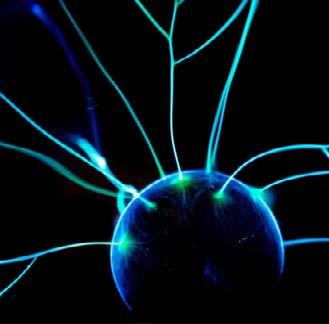
VIC: https://australian.physio/pd/pd-product?id=7982

42 AUSTRALIAN PAIN SOCIETY NEWSLETTER VOLUME 41, ISSUE 4, JUNE 2021 EDUCATION & SURVEY
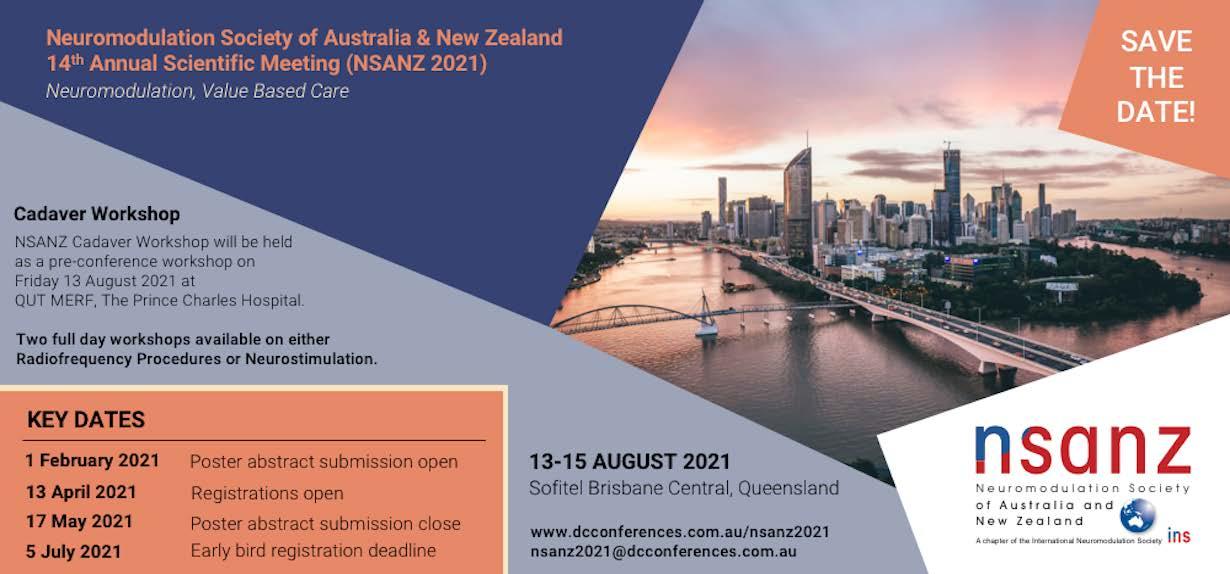
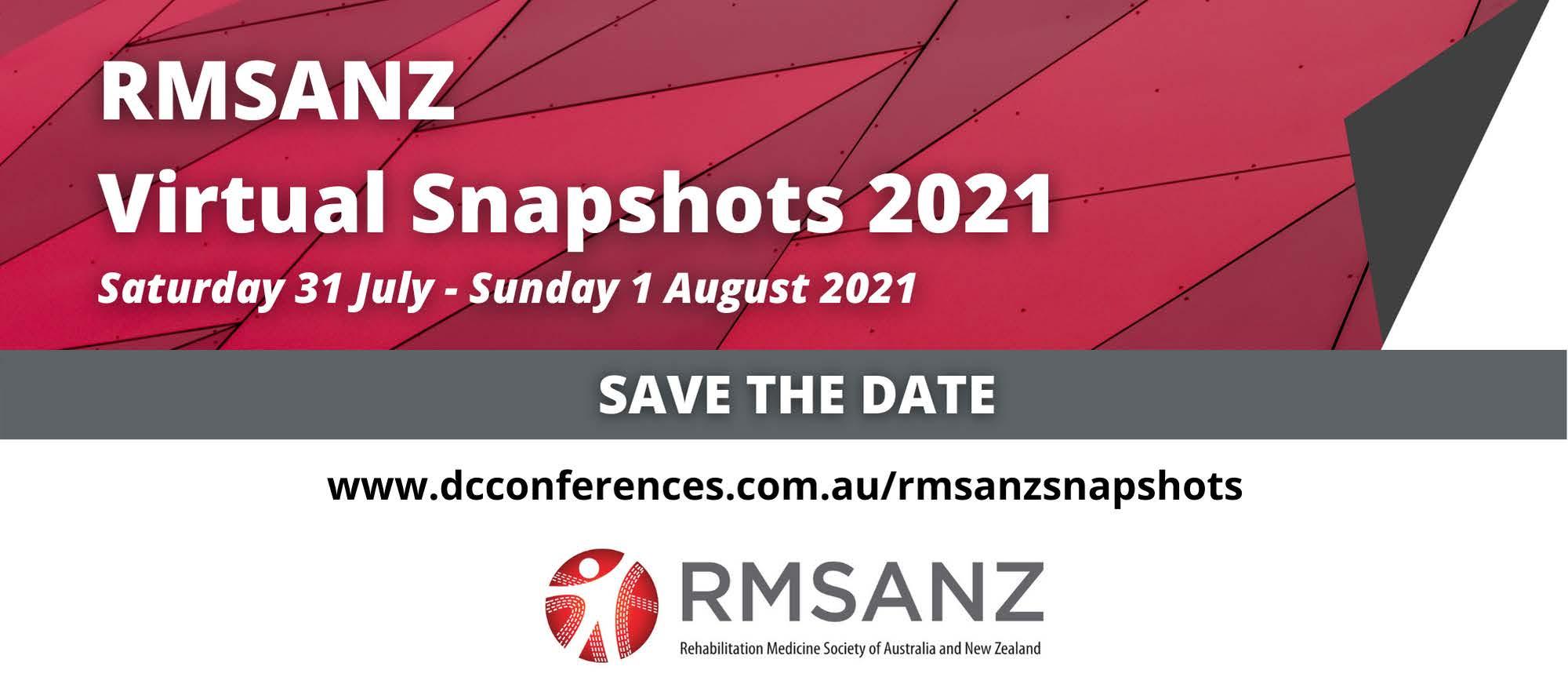

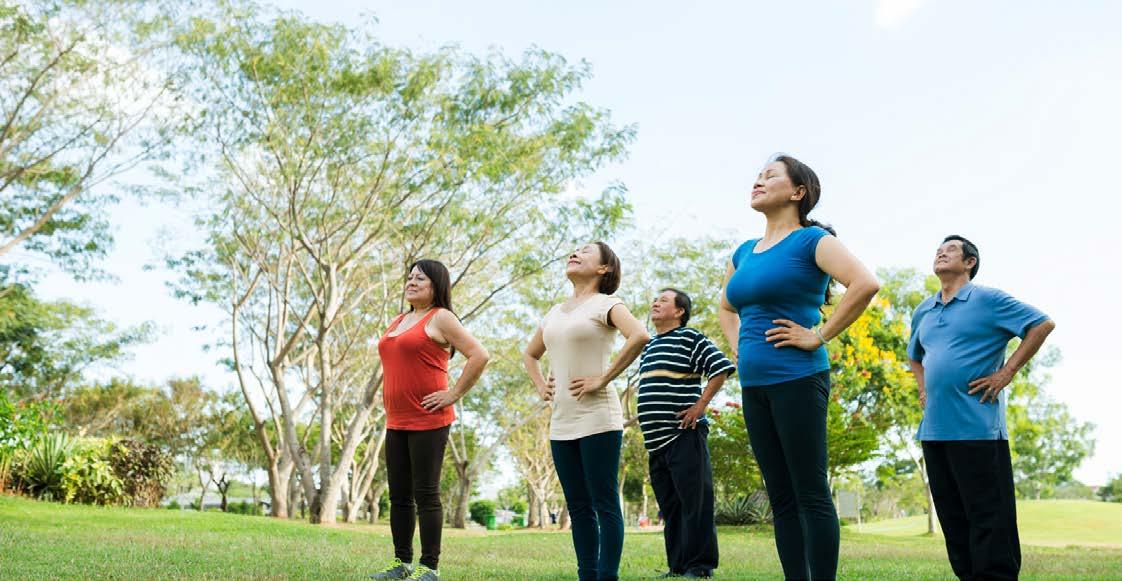

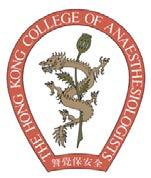
43 VOLUME 41, ISSUE 4, JUNE 2021 AUSTRALIAN PAIN SOCIETY NEWSLETTER EVENTS & NOTIFICATIONS Moving with pain 15-17 October 2021 Millennium hotel Queenstown, New Zealand The 2021 Combined Spring Meeting of the Faculty of Pain Medicine and the Hong Kong College of Anaesthesiologists #painCSM21 Save the date
Link
www.dcconferences.com.au/ssa2021
An educational initiative brought to you by the Australian Pain Society and the IASP

Inaugural event in South Australia: 14-18 November 2021

Important dates:
Applications: Opening Soon
Application deadline: 14 July 2021
Notification date: 11 August 2021
Sydney Spine Society of Australia
32nd Annual Scientific Meeting
International Convention Centre
Sydney | 26 - 28 November 2021

44 AUSTRALIAN PAIN SOCIETY NEWSLETTER VOLUME 41, ISSUE 4, JUNE 2021 EVENTS & NOTIFICATIONS
THE DATE
SAVE
to https://www.ispp2022.nz/website/17292/


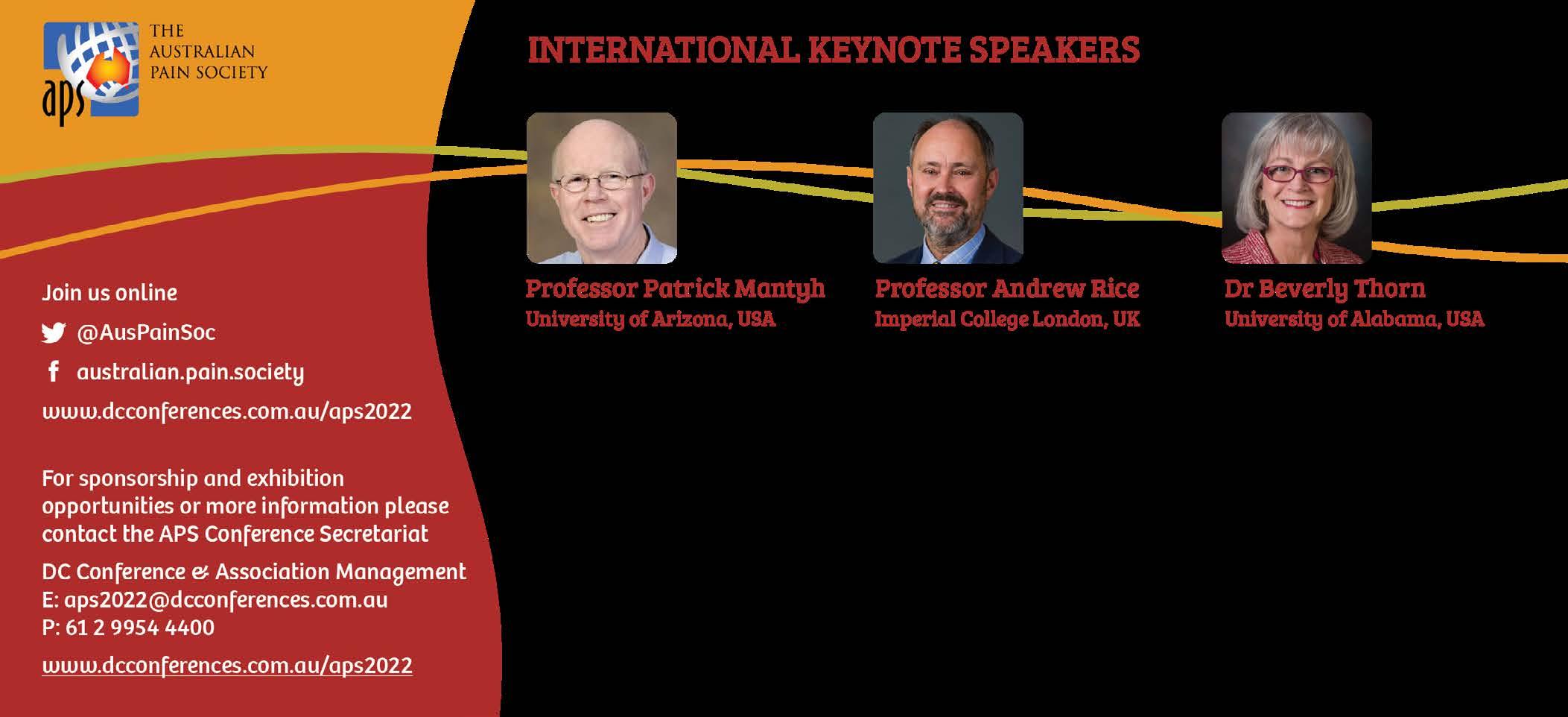
45 VOLUME 41, ISSUE 4, JUNE 2021 AUSTRALIAN PAIN SOCIETY NEWSLETTER EVENTS & NOTIFICATIONS
• ACSQHC Fourth Atlas 2021: https://www.safetyandquality.gov.au/our-work/healthcare-variation/ fourth-atlas-2021
Covering the following six clinical areas:
1. Early planned births
2. Chronic disease and infection
3. Ear, nose and throat surgery in children and young people
4. Lumbar spinal surgery
5. Gastrointestinal investigations; and
6. Medicines use in older people
Other items of interest for our members:
• Latest opioid data from the Australian Bureau of Statistics: Opioid induced deaths in Australia. https://www.abs.gov.au/articles/opioid-induced-deaths-australia
• Australia’s annual overdose report 2019 from the Pennington institute: http://www.penington.org. au/australias-annual-overdose-report-2019/
• The Third Australian Atlas of Healthcare Variation: This series explores how healthcare use in Australia varies depending on where people live. It investigates reasons for variation that may be unwarranted, and provides specific achievable actions to reduce unwarranted variation https://www.safetyandquality.gov.au/atlas
• Painaustralia eNewsletter latest issue, available online at http://www.painaustralia.org.au/media/ enews
• ePPOC: electronic Persistent Pain Outcomes Collaboration: The electronic Persistent Pain Outcomes Collaboration (ePPOC) is an Australasian initiative that aims to improve the quality of care and outcomes for people who experience chronic pain. For more information about ePPOC, refer to the website: http://ahsri.uow.edu.au/eppoc/index.html
• PainHEALTH website: painHEALTH‘s aim is to help health consumers with musculoskeletal pain access reliable, evidence-based information and tips to assist in the co-management of musculoskeletal pain. painHEALTH is an initiative of the Department of Health, Western Australia. http://painhealth.csse.uwa.edu.au/
• Stanford University: CHOIR Collaborative Health Outcomes Information Registry https://choir. stanford.edu/
• Opioid Podcasts for GPs: These podcasts are produced by David Outridge GP, and FAChAM Trainee as a project under the auspices of Dr Steven Kelly Staff Specialist in Addiction Medicine, Kullaroo Clinic Gosford. A 20 week series from the Hunter Postgraduate Medical Institute (University of Newcastle): http://www.gptraining.com.au/recent-podcasts
46 AUSTRALIAN PAIN SOCIETY NEWSLETTER VOLUME 41, ISSUE 4, JUNE 2021 FYI
FYI NEW!
• Airing Pain: Pain resources via an online radio show produced by Pain Concern, a UK registered Charity: http://painconcern.org.uk/airing-pain/
• Digital Health Guide: Developed by Primary Health Network Tasmania, check out the pain resources by accessing the link https://digitalhealthguide.com.au/Account/ LogOn?ReturnUrl=%2fSpecialtyFormulary%2f2 At login, Username: connectingcare, Password: health
• Indigenous Resources: New webpage on the APS website aggregating Indigenous resources: https://www.apsoc.org.au/Indigenous-Resources
NPS MedicineWise resources:
• Choosing Wisely Australia – News & media: https://www.choosingwisely.org.au/news-events/mediareleases/choosing-wisely-resource-addresses-patient-opioid-knowledge-gap
• Over the counter codeine – changes to supply: https://www.nps.org.au/medical-info/clinical-topics/ over-the-counter-codeine-changes-to-supply
• Medicines with codeine – what you need to know: https://www.nps.org.au/consumers/medicineswith-codeine-what-you-need-to-know
• Information about opioids and chronic non-cancer pain: U-tube clip (5.39mins) https://www.youtube. com/watch?v=8R4RT0pUCf4&feature=share&fbclid=IwAR2dbhzgEAcc7B-ogq2a6Xhud5FDkbciPbdJ9 pb94GnQI6pAeifGd1VP-_I
• Opioids: Communications videos: https://www.nps.org.au/opioids-communication-videos
TGA
• Codeine information hub: https://www.tga.gov.au/codeine-info-hub
NSW Agency for Clinical Innovation resources:
• Brainman and Pain Tool Kit translations, SEP15: http://www.aci.health.nsw.gov.au/chronic-pain/ translated-resources
• Pain Management Resources: http://www.aci.health.nsw.gov.au/resources/pain-management
• Quicksteps to Manage Chronic Pain in Primary Care: http://www.aci.health.nsw.gov.au/chronic-pain/ health-professionals/quick-steps-to-manage-chronic-pain-in-primary-care
– Built into Quicksteps: “How to de-prescribe and wean opioids in general practice”: http://www.aci. health.nsw.gov.au/chronic-pain/health-professionals/quick-steps-to-manage-chronic-pain-inprimary-care/how_to_de-prescribe_and_wean_opioids_in_general_practice
• A list of helpful apps for consumers and clinicians now available at: http://www.aci.health.nsw.gov. au/chronic-pain/health-professionals/management-of-chronic-pain
• Chronic Pain in the ED: https://www.aci.health.nsw.gov.au/networks/eci/clinical/clinical-resources/
47 VOLUME 41, ISSUE 4, JUNE 2021 AUSTRALIAN PAIN SOCIETY NEWSLETTER FYI
New Members at 26 May 2021
Mrs Bianca Antoniolli Occupational Therapy
Mrs Melissa Armstrong Pharmacy
Dr Irina Baleanu-Mackinlay Pain Medicine Physician
Mr Anthony Berrick Psychology
Dr Karrar Bohreh Surgery
Ms Holly Bradstreet Nursing
Miss Miriam Dillon Physiotherapy
Mr Ben Douglas Physiotherapy
Prof Edward Fan Anaesthesia
Mrs Bethany Grant Physiotherapy
Dr Kin Lau General Practice
Dr Kevin McCarthy Pain Medicine Physician
Dr Estelle Petch Rehabilitation Medicine
Miss Stephanie Rogan Physiotherapy
Dr Antony Scanlan Anaesthesia
Mrs Lynette Tapsell Physiotherapy
Mr Corey Weller Nursing
48 AUSTRALIAN PAIN SOCIETY NEWSLETTER VOLUME 41, ISSUE 4, JUNE 2021 NEW
MEMBERS
Calendar of Events
These dates and events are current at the time of publication. Due to the current health concerns with COVID-19, we recommend you make your own enquiries before planning to attend
9 - 18 June 2021
International Association for the Study of Pain (IASP) IASP 2021 World Congress on Pain
Online https://www.iaspworldcongress.org
23-25 June 2021
Occupational Therapy Australia
Inspired Insights for Brighter Futures - Hybrid Conference
Cairns Convention Centre, Cairns, QLD
https://www.otaus2021.com.au
31 July - 8 August 2021
Rehabilitation Medicine Society of Australia and New Zealand
Rehabilitation Virtual Snapshots Meeting
Online https://dcconferences.eventsair.com/ rmsanzsnapshots2021/
13-15 August 2021
Neuromodulation Society of Australia & New Zealand (NSANZ)
Neuromodulation, Value Based Care
Sofitel Brisbane Central, Brisbane, QLD
https://www.dcconferences.com.au/nsanz2021/
2-4 September 2021
International Neuromodulation Society
2nd Joint Congress of the INS European Chapters
Palais des Congrès de Paris, France
https://e-ins.org/
10 - 12 September 2021
RACGP - GP21
Melbourne Convention and Exhibition Centre
https://www.racgp.org.au/gp21/gp21-home
20 - 23 Oct 2021
Australian College of Rural and Remote Medicine (ACRRM) and Rural Doctors
Association of Australia (RDAA)
Rural Medicine Australia - Respond. Recover. Reflect. Renew.
Crowne Plaza, Hunter Valley, NSW
https://rma.acrrm.org.au/register
21-23 October 2021
Australian Physiotherapy Association
APA 2021 Conference
Brisbane Convention and Exhibition Centre, Brisbane, QLD
https://australian.physio/pd/conferences-andmasterclasses
11-13 November 2021
Australian and New Zealand Association of Oral & Maxillofacial Surgeons
ANZAOMS 2021 Conference Hotel Grand Chancellor, Hobart, Tasmania
https://www.anzaomsconference.com.au/
26 - 28 November 2021
Spine Society of Australia
32nd Annual Scientific Meeting
ICC, Sydney, NSW
https://dcconferences.eventsair.com/ssa-2021/
24-27 March 2022
IASP Pain in Childhood SIG
ISPP 2022 13th International Symposium on Pediatric Pain: Diversity, Equity, Access Cordis Hotel, Auckland, New Zealand
http://childpain.org/index.php/symposium/
20 - 22 May 2022
Australian Psychological Society College of Clinical Psychologists Complexity in Practice2021 Annual Conference
Sofitel Brisbane Central, Brisbane, QLD
https://www.psychology.org.au/APS-CCLINConf/2020
7 - 10 June 2022
Rehabilitation Medicine Society of Australia and New Zealand (RMSANZ)
5th Annual Scientific Meeting: Forging Alliances, New Horizons
Gold Coast Convention and Exhibition Centre, Gold Coast, QLD
https://www.dcconferences.com.au/rmsanz2022/
49 VOLUME 41, ISSUE 4, JUNE 2021 AUSTRALIAN PAIN SOCIETY NEWSLETTER CALENDAR OF EVENTS
Vision, Mission & Priorities
Vision:
All people will have optimal access to pain prevention and management throughout their life.
Mission:
The Australian Pain Society is a multidisciplinary association whose mission is to advance pain prevention, management and clinical practice.
Priorities:
In order to achieve our mission, the Australian Pain Society will provide:
• Education
• Advocacy
• Research
• Services and resources
• Membership
• Good governance and operations
50 AUSTRALIAN PAIN SOCIETY NEWSLETTER VOLUME 41, ISSUE 4, JUNE 2021
VISION, MISSION & PRIORITIES
APS Directors
President:
Ms Trudy Maunsell
Acute Pain Service
Princess Alexandra Hospital
Woolloongabba QLD 4102
Tel: 07 3176 5547 Fax: 07 3176 5102
President-Elect:
Mrs Joyce McSwan
Gold Coast Primary Health Network
Persistent Pain Program, QLD and PainWISE
Tel: 0412 327 795 Fax: 07 3539 9801
Secretary:
Mrs Dinah Spratt
Physiotas Physiotherapy
Shearwater TAS 7307
Tel: 03 6428 7500 Fax: 03 6424 7811
Treasurer
Mr Tim Austin
Camperdown Physiotherapy
Newtown NSW 2042
Tel: 02 9517 1787 Fax: 02 9516 2491
ACT Director:
Dr Andrew Watson


Calvary Hospital
Canberra ACT 2617
Tel: 02 6201 6352
NSW Director:
Dr Tim Ho

Inner West Pain Centre
RPA Medical Centre
Newtown NSW 2042
Tel: 02 9517 1764 Fax: 02 9517 1832
NT Director:
Dr Rav Harish
Alice Springs Hospital
Central Australian Health Service
Alice Springs NT 0871
Email: rav.harish@nt.gov.au

QLD Director:

Mrs Karalyn Huxhagen
KH Pharmacy Consulting
Mackay QLD 4740
Tel: 0418 185 972 Fax: 07 4805 6155
SA Director:
Dr Michelle Harris

Royal Adelaide Hospital and Lyell McEwin Hospital
Adelaide SA
Email: michelle.harris2@sa.gov.au
TAS Director:
Ms Bernadette Smith
Psychology Plus
South Burnie TAS
Tel: 03 6431 9959 Fax: 03 6431 9950
VIC Director:
Dr Laura Prendergast Pain Service, Austin Health






Heidelberg VIC 3084
Tel: 03 9496 3134 or 03 5832 3020
WA Director:
Ms Jacintha Bell
Lifeworks Occupational Therapy
Subiaco WA 6008
Tel: 0451 178 880 Fax: 08 6323 3329
51 VOLUME 41, ISSUE 4, JUNE 2021 AUSTRALIAN PAIN SOCIETY NEWSLETTER
APS DIRECTORS
Office Bearers
Immediate Past President:
A/Prof Anne Burke
Central Adelaide Local Health Network
Royal Adelaide Hospital
Adelaide SA 5000
Tel: 08 7074 2835 Fax: 08 7074 6247
SPC Chair:
A/Prof Kevin Keay



Department of Anatomy
University of Sydney
Sydney NSW 2006
Tel: 02 9351 4132 Fax: 02 9351 2817
IASP Liaison:
Professor Michele Sterling



RECOVER Injury Research Centre
University of Queensland
Herston QLD 4029
Tel: 07 3346 4793
Website: https://www.iasp-pain.org
Communications Coordinator:
Ms Trudy Maunsell
Acute Pain Service
Princess Alexandra Hospital
Woolloongabba QLD 4102
Tel: 07 3176 5547 Fax: 07 3176 5102
Newsletter Editor:
Dr Lincoln Tracy
School of Public Health and Preventive Medicine
Monash University
Melbourne VIC 3004
Tel: 03 9903 0288
Newsletter Assistant Editor:
Dr Joanne Harmon

School of Clinical and Health Sciences
University of South Australia
Adelaide SA 5000
Tel: 08 8302 1442
PhD Scholarship Chair:
A/Prof Michael Farrell
Retired VIC
Secretariat: DC Conference & Association
Management Pty Ltd
PO Box 637
North Sydney, NSW 2059
Tel: 02 9016 4343
Email: aps@apsoc.org.au
Website: apsoc.org.au
52 AUSTRALIAN PAIN SOCIETY NEWSLETTER VOLUME 41, ISSUE 4, JUNE 2021 OFFICE BEARERS







































































